Connections
with the Phonograph

By
Willa Cather ©1922, Alfred A. Knopf, Inc.
By Doug Boilesen, 2022
Each book selected by Friends of
the Phonograph in Phonographia's Library
of PhonoLiterature has at least one phonograph in its story.
One of Ours by Willa Cather has
several phonographs but many more phonograph connections (primarily
songs which became popular phonograph records during World War I)
with its discography
(playlist) larger than any other book in the PhonoLiterature Library.
These connections are also historically
noteworthy because World War I music was an important part of the
"messaging" which supported the Allies at home and in the
trenches. As Neil Harris and Teri Edelstein wrote in En Guerre:
French Illustrators and World War I, the production of unending
messages "with a consumerist orientation" was for the most
part "to bolster morale, arouse indignation, ridicule the enemy,
glorify heroic traditions, add some needed humor, and satisfy the
need for diversion during the long agonies of war." (1)
Organized by subjects, each section
of this page starts with text from One of Ours.
Strings
in the following subjects include endpoints which are phonographs,
phonograph records, sheet music and other phonograph related connections.
Connections
with the Phonograph
Subjects include the following:
"Bidding
the eagles of the West fly on . . .", Mechanical
Devices, the Phonograph,
Dislike of Phonograph Music,
Dull without the Phonograph
on Winter Evenings, Phonograph
Monologues, David
Hochstein, Neutrality,
Edith Cavell, the Lusitania,
the United States's Entry into
the War, Submarine Warfare,
His Master's Voice, Battle
of the Marne, Claude Prepares
for France, Camp Dix,
"Good-bye Broadway, Hello
France," "Statue
of Liberty," "Over
There," Claude's
Ship Arrives in France, General
Pershing, Trench Warfare,
"Home, Sweet Home,"
Aeroplanes and Victor Morse,
Support for the Troops,
the Bugle,
A Mother's loss, Armistice,
Good-Bye France, "Everybody's
Happy Now," Summary
and Discography.
LISTENING to RECORDS and the BACK
Button
All records on this page can be played
(see Instructions for listening to
records), however, this page is not optimized for small screens. If
you are using an iPad see iPad Back
Button for related information.

"Bidding
the eagles of the West fly on . . ."
"One of Ours
is the intimate story of a young man's life. Claude
Wheeler's stormy youth, his enigmatic marriage, and the final
adventure which releases the baffled energy of the boy's nature..."
Excerpt from cover of the 1922
novel written by Alfred E. Knopf, publisher of One of Ours.
Mechanical Devices
The first reference to the phonograph
in One of Ours is not specific but sets the context of Ralph's
acquisitions of mechanical contraptions and his upcoming purchase
of "another music machine." There is an on-going debate
between Ralph and his mother, Mrs. Wheeler, who admits that she is
"old-fashioned" and struggles to use any of the devices
Ralph has purchased for her home, seeing them also as a waste of money.
It starts with the cream separator.
"Now, Mother," said Ralph good-humouredly,
as he emptied the syrup pitcher over his cakes, "you're prejudiced.
Nobody ever thinks of skimming milk now-a-days. Every up-to-date
farmer uses a separator."
Mrs. Wheeler's pale eyes twinkled.
"Mahailey and I will never be quite up-to-date, Ralph. We're old-fashioned,
and I don't know but you'd better let us be. I could see the advantage
of a separator if we milked half-a-dozen cows. It's a very ingenious
machine. But it's a great deal more work to scald it and fit it
together than it was to take care of the milk in the old way."
"It won't be when you get used to
it," Ralph assured her. He was the chief mechanic of the Wheeler
farm, and when the farm implements and the automobiles did not give
him enough to do, he went to town and bought machines for the house.
As soon as Mahailey got used to a washing-machine or a churn, Ralph,
to keep up with the bristling march of events, brought home a still
newer one. The mechanical dish-washer she had never been able to
use, and patent flat-irons and oil-stoves drove her wild. (pp. 32-33)
More examples follow of "mechanical
toys" and "mysterious objects" purchased by Ralph.
The cellar was cemented, cool and
dry, with deep closets for canned fruit and flour and groceries,
bins for coal and cobs, and a dark-room full of photographer's apparatus.
Claude took his place at the carpenter's bench under one of the
square windows. Mysterious objects stood about him in the grey twilight;
electric batteries, old bicycles and typewriters, a machine for
making cement fence-posts, a vulcanizer, a stereopticon with a broken
lens. The mechanical toys Ralph could not operate successfully,
as well as those he had got tired of, were stored away here. If
they were left in the barn, Mr. Wheeler saw them too often, and
sometimes, when they happened to be in his way, he made sarcastic
comments. Claude had begged his mother to let him pile this lumber
into a wagon and dump it into some washout hole along the creek;
but Mrs. Wheeler said he must not think of such a thing, as it would
hurt Ralph's feelings very much. Nearly every time Claude went into
the cellar, he made a desperate resolve to clear the place out some
day, reflecting bitterly that the money this wreckage cost would
have put a boy through college decently. (p. 35)
The language of "mechanical"
is also seen multiple times in relation to mechanical actions and
state-of-minds. See One of Ours Endnote "Mechanical"
for examples.
The Phonograph
"The latest make, put out under
the name of a great American inventor."
The phonograph is first identified in
One of Ours with Ralph purchasing another music machine, "the
latest make, put out under the name of a great American inventor."
The next few weeks were busy ones
on the farm. Before the wheat harvest was over, Nat Wheeler packed
his leather trunk, put on his "store clothes," and set off to take
Tom Wested back to Maine. During his absence Ralph began to outfit
for life in Yucca county. Ralph liked being a great man with the
Frankfort merchants, and he had never before had such an opportunity
as this. He bought a new shot gun, saddles, bridles, boots, long
and short storm coats, a set of furniture for his own room, a fireless
cooker, another music machine, and had them shipped to Colorado.
His mother, who did not like phonograph music, and detested phonograph
monologues, begged him to take the machine at home, but he assured
her that she would be dull without it on winter evenings. He wanted
one of the latest make, put out under the name of a great American
inventor. (p. 103)
The latest phonograph made "under
the name of a great American inventor" was, of course, a Thomas
A. Edison Phonograph. The Edison signature was a feature of Edison's
marketing along with the phrase "Genuine Edison Phonograph."
(1A)
This 1900 Cosmopolitan ad includes
Edison's picture with his signature below it and the Edison phonograph
ad tag line: "None genuine without this Thomas A. Edison Trade
Mark " (signature).

Cosmopolitan magazine,
December 1900
Ralph is beginning to "outfit
for life in Yucca county" when he purchases a new Edison phonograph
so the time period is probably between 1906 and 1908.(1AA)
The Edison Home or
Edison Triumph Phonograph would be good possibilities for the
model of the machine Ralph purchased.
(1B). For more about the
phonograph industry's timeline and cylinder vs. disc machines see
(1C). See
(1D) regarding The Willa Cather
Scholarly Edition's One
of Ours Explanatory Note 103.
As the "great American inventor"
and President of Thomas A. Edison, Inc., Edison's phonograph company
would continue through the teens and into the twenties to be one of
the big three in the U.S. phonograph industry. What Edison did and
said was a common item in the popular press. When Edison published
"Messages" to his
Dealers from 1917-1919 in the trade magazine The Talking Machine
World the "Wizard" was offering his perspectives on
the war, business and the importance of music which are themselves
interesting pieces of war-time popular culture.
Mrs. Wheeler "did
not like phonograph music"
His mother, who did not like phonograph
music, and detested phonograph monologues...(p. 103)
The phonograph had its detractors in
its early years but circa 1907 the fact that Mrs. Wheeler "did
not like phonograph music" was a minority opinion and in contrast
to the many consumers who were interested in the growing catalogs
of phonograph music and recorded entertainment: bands, orchestras,
instrumental, musical groups and performing artists; solos by accordian,
banjo, bagpipe, bells, church chimes, clarinet, cornet, dulcimer,
flute, harp, mandolin, oboe, organ, piccolo, piano, piccolo, trombone,
trumpet, violin, violoncello, whistling, xylophone and zither;
and its monologue records, also known as descriptive, vaudeville,
recitation, sketch and "dialect" records. (1E)
John Philip Sousa, who was well-known
for his band and military march music and who also made records, famously
wrote what he didn't like about player pianos and phonographs in a
1906 magazine article titled "The Menace of Mechanical Music."
Sousa railed against the phonograph and its damage to America's musical
future, warning that "mechanical music was sweeping across the
country" and
was becoming a “substitute for human skill, intelligence and soul.”
"Then
what of the national throat? Will it not weaken?" (1F)
"Will
the infant be put to sleep by machinery" asked Sousa. (1G)

"The Menace of Mechanical
Music" by John
Philip Sousa, Appleton's
Magazine,
September 1906
Mrs. Wheeler "detested
phonograph monologues."
His mother, who did not like phonograph
music, and detested phonograph monologues...(p. 103)
The "monologue" records which
Mrs. Wheeler detested were also known as descriptive, vaudeville,
recitation, sketch and "dialect" records and were first
heard on the nickel-in-the-slot phonographs in the 1890's. Some of
these early monologues and songs contained bawdy and risque content.
In 1891 Russell Hunting began making one of the most famous monologue
record series of its time featuring his Irish character, "Michael
Casey." But Hunting's recording career was interrupted when
he was arrested on June 24,1896 for making and distributing obscene
records. In the case, "widely reported in the press," Hunting
was "sentenced to three months in prison for violating the same
obscenity laws that governed written literature and visual images."
(2). While in jail Hunting also lost
the monopoly over his Casey series but he would continue making records
and nearly twenty-five years later was still making "Casey"
records with his "descriptive" Pathe World War I
record titled "Casey
Home From The Front".
In the first decade of 20th century
Harlan and Stanley had their "Rube
Series" of records (Disclaimer);
Len Spencer had his so called "colorful dialogues" involving
numerous ethnicities; William F. Denny had what Edison advertised
as "his great monologue"
entitled "A
Matrimonial Chat." Billy Golden and Joe Hughes' vaudeville
sketch about the Mexican Expedition (a.k.a. the Pancho Villa Expedition)
titled "Jimmy
Triggers Return from Mexico." Cal Stewart, known as the "Yankee
Story Teller," became famous in his role as Uncle Josh Weathersby
and his Edison record titled Uncle
Josh and the Lightning Rod Agent is an example of his New England
humor.
Columbia, Victor and other talking machine
companies besides Edison made "monologue" records and performers
like all of the above recorded for multiple companies. Edison therefore
wasn't alone in making monologue records, however, the following 1908
Edison ad for "Broadway Vaudeville" featuring entertainment
by Uncle Josh shows popular culture that is probably a closer fit
for a Nebraska homestead than the opera stages promoted by Victor
and Columbia.
No record, however, was welcomed in
Mrs. Wheeler's Nebraska home, and especially any phonograph monologue.
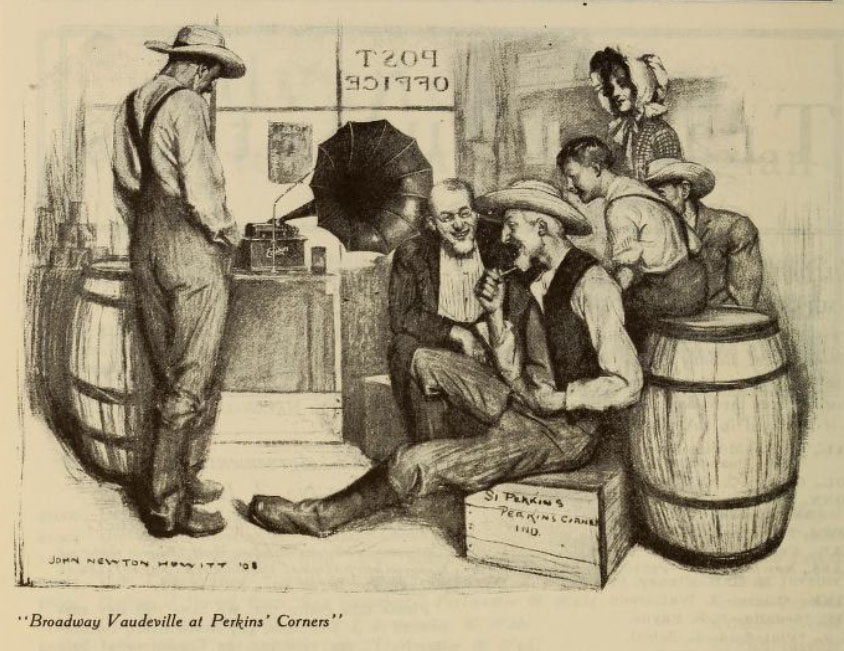
The Edison Phonograph Monthly
showing what Edison was using for their August 1908 national advertisements.
In contrast to the phonograph monologues
and recitations, a variety of music and opera was offered to its listeners
presenting "The whole show" and "The
Stage of the World." "A single evening with the Graphophone
offers thousands of dollars in professional services." Its scientific
improvements, said a 1906 Columbia ad, "have resulted in reproducing
the exact human tone quality and volume of the original."
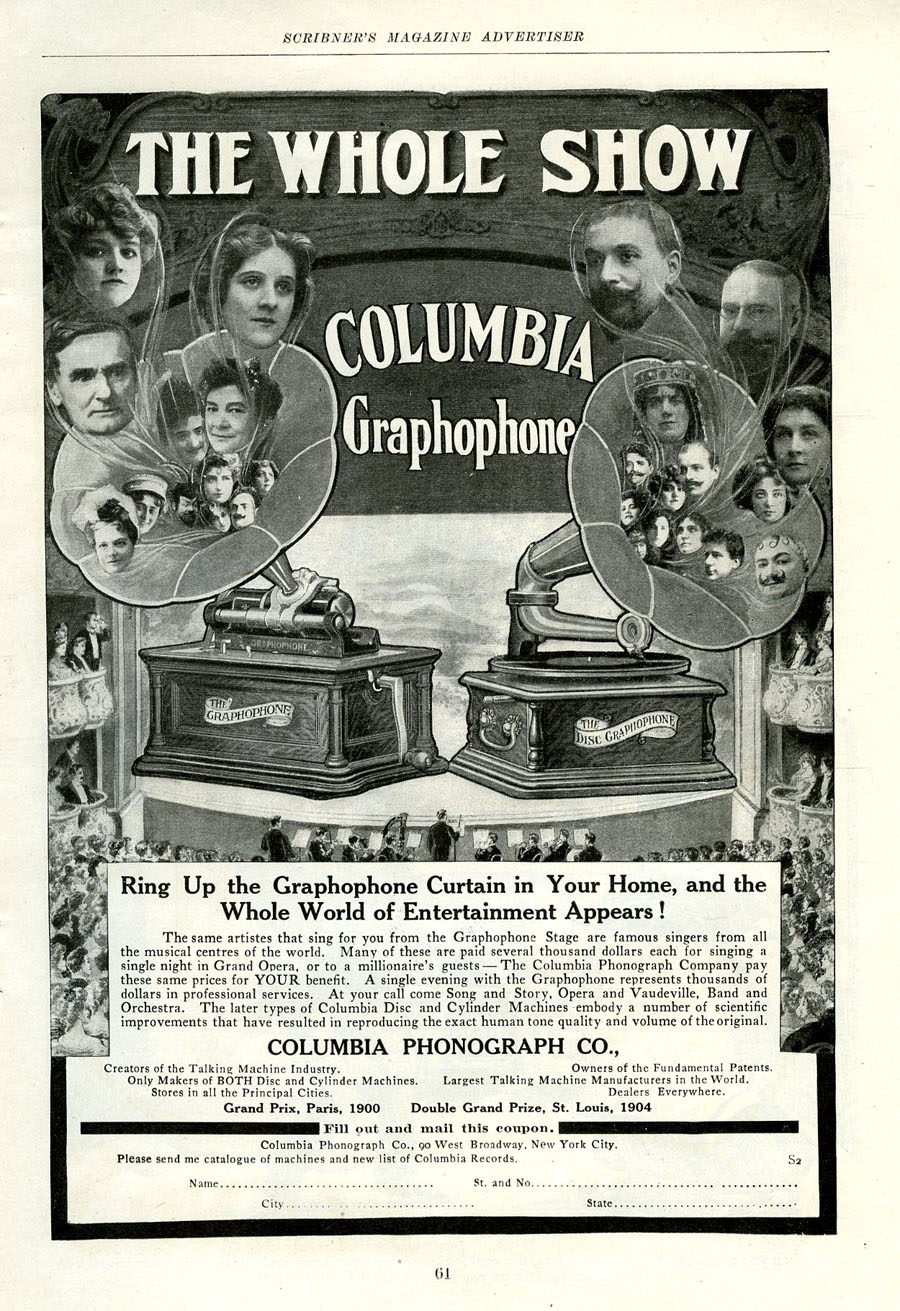
"Ring Up the Graphophone
Curtain in Your Home, and the Whole World of Entertainment Appears!"
1906

"Verdi's Masterpiece,
"Il Trovatore", complete, from the opening chorus to the finale
of the last act...of the La Scala Theatre, Milan, Italy." Munsey's,
Victor Talking Machine Co., 1906
"dull without
it on winter evenings."
Ralph is buying another phonograph for
his new home and his mother doesn't want him to leave the old one
with her.
His mother...begged him to take
the machine at home, but he assured her that she would be dull without
it on winter evenings. (p. 103)
The phonograph, as it became a consumer
product in the mid-1890's, started to increase its phonograph advertising
and this included repeatedly promoting it as the “finest entertainer
in the world,” "always ready to entertain," and the clear
answer for how to spend your evenings (especially in the long, cold,
dark, shivery evenings"):

Top section of 1899
broadside advertisement.
See Evenings
in Any Season are Never Dull with a Phonograph for advertising
examples of the phonograph as the unmatched entertainer for any evening.
See "Antique Phonograph, Gadgets,
Gizmos & Gimmicks" for a novelty trade card depicting "a
dull evening at home," circa 1908. By holding the card to the
light a Zon-O-Phone magically appears as the "Ideal Home Entertainer
- it drives dull care away." (2A)
"singing snarl
of a phonograph."
The next reference to the phonograph
was less than complimentary regarding listening to the "singing
snarl of a phonograph."
That evening Claude was sitting
on the windmill platform, down by the barn, after a hard day's work
ploughing for winter wheat. He was solacing himself with his pipe.
No matter how much she loved him, or how sorry she felt for him,
his mother could never bring herself to tell him he might smoke
in the house. Lights were shining from the upstairs rooms on the
hill, and through the open windows sounded the singing snarl of
a phonograph. (p. 110)
"before the
days of Victrolas."
The Victrola was introduced by the Victor
Talking Machine Company in 1906. Its popularity would make it a generic
term for early phonographs and talking machines, especially for machines
with their horn enclosed within its cabinet. Edison's "Phonograph"
was also a trade-marked name that in the U.S. would become a generic
term for record players. See Phonographia's PhonoAds
Pre-1900 for more details about the early marketing of the phonograph
as a home entertainment machine prior to the introduction of the Victrola.
Claude decided he would go to the
Yoeders' today, and to the Dawsons' tomorrow. He didn't like to
think there might be hard feeling toward him in a house where he
had had so many good times, and where he had often found a refuge
when things were dull at home. The Yoeder boys had a music-box long
before the days of Victrolas, and a magic lantern, and the old grandmother
made wonderful shadow-pictures on a sheet, and told stories about
them. She used to turn the map of Europe upside down on the kitchen
table and showed the children how, in this position, it looked like
a Jungfrau; and recited a long German rhyme which told how Spain
was the maiden's head, the Pyrenees her lace ruff, Germany her heart
and bosom, England and Italy were two arms, and Russia, though it
looked so big, was only a hoopskirt. This rhyme would probably be
condemned as dangerous propaganda now! (p. 340)

The 1907 Victor-Victrola
the Sixteenth 1907-1921 (Courtesy of WorthPoint) See
End Notes 'Victrolas' for more details.
"music-machines
poured out jazz tunes and strident Sousa marches"
"From every doorway music-machines
poured out jazz tunes and strident Sousa marches. The noise was stupefying."
The sidewalks were crowded with
chairs and little tables, at which marines and soldiers sat drinking
sirops and cognac and coffee. From every doorway music-machines
poured out jazz tunes and strident Sousa marches. The noise was
stupefying. Out in the middle of the street a band of bareheaded
girls, hardy and tough looking, were following a string of awkward
Americans, running into them, elbowing them, asking for treats,
crying, "You dance me Fausse-trot, Sammie?" (p.
437)
"Jazz, Fox-Trot"
("You dance me Fausse-trot,
Sammie?")

Original Jazz, Fox-Trot "
The Kaiser's Got the Blues," by Waldron, F. D., published by
Frank D. Waldron, Tacoma, 1918 (Courtesy Library of Congress)
"noise of the
phonograph"
The violin and recording artist David
Gerhardt (who was largely based on the concert violinist David Hochstein)
kept his concentration despite the talk and noise of the phonograph.
(2AA)
Claude knew that David particularly
detested Captain Owens of the Engineers, and wondered that he could
go on working with such concentration, when snatches of the Captain's
lecture kept breaking through the confusion of casual talk and the
noise of the phonograph. Owens, as he walked up and down, cast furtive
glances at Gerhardt. He had got wind of the fact that there was
something out of the ordinary about him. (p. 488)
David Hochstein and the powers of
the phonograph
The phonograph's powers to capture and
share music anywhere and anytime exemplifies the unique attributes
of the phonograph and its records. The "anywhere" allows
music to be shared no matter where someone is located. The "anytime"
removes restrictions both for when one can listen but also as for
whether or not the performer is even alive. As the Victor ad of 1918
stated "Jenny Lind is
only a memory, but the voice of Melba can never die."
Phonograph records preserved the art
of violinist David Hochstein, the prototype for Lieutenant David Gerhardt,
so that his art could potentially be shared with anyone at anytime.
If Claude's mother could hear Gerhardt's records Claude believed that
"it will sort of bring the whole thing closer to her, don't you
see?"
 
David Hochstein (Courtesy Rochester
Public Library) and G.P. Cather in Nebraska National Guard, 1916
(Illustration 14, One of Ours, Willa Cather Scholarly Edition,
2006, University of Nebraska Press, Lincoln)
The men kept the phonograph going;
as soon as one record buzzed out, somebody put in another. Once,
when a new tune began, Claude saw David look up from his paper with
a curious expression. He listened for a moment with a half-contemptuous
smile, then frowned and began sketching in his map again. Something
about his momentary glance of recognition made Claude wonder whether
he had particular associations with the air,—melancholy, but beautiful,
Claude thought. He got up and went over to change the record himself
this time. He took out the disk, and holding it up to the light,
read the inscription: "Meditation from Thaïs—Violin solo—David Gerhardt."
When they were going back along
the communication trench in the rain, wading single file, Claude
broke the silence abruptly. "That was one of your records they played
tonight, that violin solo, wasn't it?"
"Sounded like it. Now we go to the
right. I always get lost here."
"Are there many of your records?"
"Quite a number. Why do you ask?"
"I'd like to write my mother. She's
fond of good music. She'll get your records, and it will sort of
bring the whole thing closer to her, don't you see?"
"All right, Claude," said David
good-naturedly. "She will find them in the catalogue, with my picture
in uniform alongside. I had a lot made before I went out to
Camp Dix. My own mother gets a little income from them. Here we
are, at home." As he struck a match two black shadows jumped from
the table and disappeared behind the blankets. "Plenty of them around
these wet nights. Get one? Don't squash him in there. Here's the
sack."
Gerhardt held open the mouth of
a gunny sack, and Claude thrust the squirming corner of his blanket
into it and vigorously trampled whatever fell to the bottom. "Where
do you suppose the other is?"
"He'll join us later. I don't mind
the rats half so much as I do Barclay Owens. What a sight he would
be with his clothes off! Turn in; I'll go the rounds." Gerhardt
splashed out along the submerged duckboard. Claude took off his
shoes and cooled his feet in the muddy water. He wished he could
ever get David to talk about his profession, and wondered what he
looked like on a concert platform, playing his violin. (pp. 488-490)
"She will find them in the catalogue,
with my picture in uniform alongside."

David Hochstein has two selections and
his photograph in the 1917 Emerson Records catalog: Fritz Kreisler's
"Liebesleid" and "Waltz in A Major" by Brahms.
Listen
to David Hochstein play Fritz Kreisler's "Liebesleid" courtesy
of Hochstein.org.

"Waltz in A Major,"
Violin Solo by David Hochstein, 1916
No record catalog has been located with
Hochstein in uniform, however, Albert Spalding, a famous violinist
who recorded for Edison also served in France in the United States
Air Corps and there is one for him. Spalding received much publicity
for his service and there are concert publicity photographs with Spalding
in uniform. See Albert Spalding, Edison
artist and violinist in France who later made a Victor record of Hochstein's
arrangement of Brahms Waltz
in A Major.

1917 Emerson Record
Catalog, p. 10 (Courtesy Internet
Archive)
The Neutrality of the United States
"The United States remained
neutral at the beginning of the war. Americans were divided in support,
although the majority were sympathetic to the Allies. Many contributed
to relief efforts; others volunteered as ambulance drivers or nurses,
or even as pilots and soldiers. Most, however, agreed with President
Woodrow Wilson’s commitment to keeping the U.S. out of the fighting."
(1)

THE TUG OF PEACE - satirical
cartoon of pacifist and industrialist Henry Ford's attempt to initiate
a peace process among the belligerents during of WWI. Punch,
December 15, 1915 (PM-1036)

The Neutrality March by Mike
Bernard, publisher Chas. K. Harris, New York, 1915. (Courtesy
The
Lester S. Levy Collection of Sheet Music, The Sheridan Libraries,
Johns Hopkins University) Midi version of The Neutrality March
can be heard on YouTube.
There was no record released for The
Neutrality March but in 1915 Bert Williams sang "I'm Neutral"
since neutrality was President Wilson's official position and a much
discussed topic in the United States.

"I'm Neutral" sung by Bert
Williams Columbia Grafonola Record A1817, 1915 (Courtesy
David Giovannoni Collection i78s.org)
"There ain't no use in talking,
folks are all up in the air...but I'm Neutral, I am and is and shall
remain just neutral..." Bert Williams
"Based on President Woodrow Wilson's
isolation stance in the early years of the first World War, "I'm
Neutral" playfully represents the challenge of remaining neutral.
The protagonist finds himself, as did most of Williams's characters,
in unfortunate circumstances. Faced with acquaintances of different
ethnic backgrounds who are biased about the war in Europe, he tries
not to get involved. In the agitated spirt of the environment, however,
he is attacked. The second verse situates him amid a fighting husband
and wife." (Ann Ommen Van der
Merwe, The Ziegfield Follies: A History in Song)
The lyrics begin with "there ain't
no use in talkin" but "somebody hocked the Kaiser and
I don't know the reason why."
"There ain't no use in talking,
folks are all up in the air, From what I can hear them saying seems
like fightin everywhere, I went down to the bulletin board the other
night, just to see what I could see, and before I knew it there
was several hundred men all surrounding me, somebody hocked the
Kaiser and I don't know the reason why, but a Frenchman took a swing
at me and dug a trench right in my eye A Russian saw my color and
he yelled "kill the Turk!" then the alley's all got in
the range and started in the works... But I'm Neutral, I am and
is and shall remain just Neutral.."

"When the Kaiser is in Hock,"
by John Peach Gilroy, Asplund & Leaf Music Printers, Seattle,
1917 (Courtesy Library of Congress)
The song "I Didn't Raise My Boy
to be a Soldier" was promoted as a "sensational anti-war
song hit." It would be recorded on several labels in 1915, among
them by Morton
Harvey for Victor Records; the Peerless
Quartette recorded on January 6, 1915 for Columbia Records; Helen
Clark recorded on February 15, 1915 for Edison Records; a Medley
One-Step version by
Jaudas' Society Orchestra recorded on May 11, 1915 for Edison
records. Each can be heard courtesy of David Giovannoni.

Sheet music and record
label courtesy of Giovanonni-Sheram Collection.

Listen
to Morton Harvey, Victor Records 17716-A (Courtesy of i78s.org and
David Giovanonni).
The United States remained neutral
even after Edith Cavell's execution and the sinking of the Lusitania
"On 7 May 1915 a German submarine
torpedoed and sank the British passenger liner Lusitania off the coast
of Ireland. Of 1,257 passengers, 1,198 died, among them 128 Americans.
President Wilson declared the sinking illegal and inhumane and asserted
that it represented a violation of "sacred human rights." The Lusitania
became a focus of both American and German propaganda....Most Americans,
though angered at the incident, called for negotiations with Germany.
In February 1916 Germany officially apologized to the United States
and offered an indemnity." One of Ours, Willa Cather
Scholarly Edition, ibid, Explanatory Note No. 293.
"Don't let me forget to give you
an article about the execution of that English nurse." "Edith Cavell?
I've read about it," he answered listlessly. "It's nothing to be
surprised at. If they could sink the Lusitania, they could shoot
an English nurse, certainly." (p. 286)
Edith Cavell

"The Bravest Heart of All - A Tribute
to Edith Cavell," by Lamb and Clique, Published by Frank K. Root
& Co., Chicago, 1915 (Courtesy
Northern Illinois University Digital Library, Lee Schreiner
Sheet Music Collection)
Leonard looked him over. "Good Lord,
Claude, you ain't the only fellow around here that wears pants!
What for? Well, I'll tell you what for," he held up three large
red fingers threateningly; "Belgium, the Lusitania, Edith Cavell.
That dirt's got under my skin. I'll get my corn planted, and then
Father'll look after Susie till I come back."
Claude took a long breath. "Well,
Leonard, you fooled me. I believed all this chaff you've been giving
me about not caring who chewed up who."
And no more do I care," Leonard
protested, "not a damn! But there's a limit. I've been ready to
go since the Lusitania. I don't get any satisfaction out of my place
any more. Susie feels the same way." (pp. 316-317).
The Lusitania

When the Lusitania Went Down
by Charles McCarron and Nat. Vincent, Publisher Leo Feitst, New York,
1915. (Courtesy The
Lester S. Levy Collection of Sheet Music)

"When the Lusitania Went Down"
Sung by Herbert Stuart, Columbia Record No. A1772, double-sided disc
recorded May 20, 1915 (Courtesy
i78s.org
and Internet
Archive)

(Sheet Music and record
courtesy of Giovannoni-Sheram Collection and i78s.org)
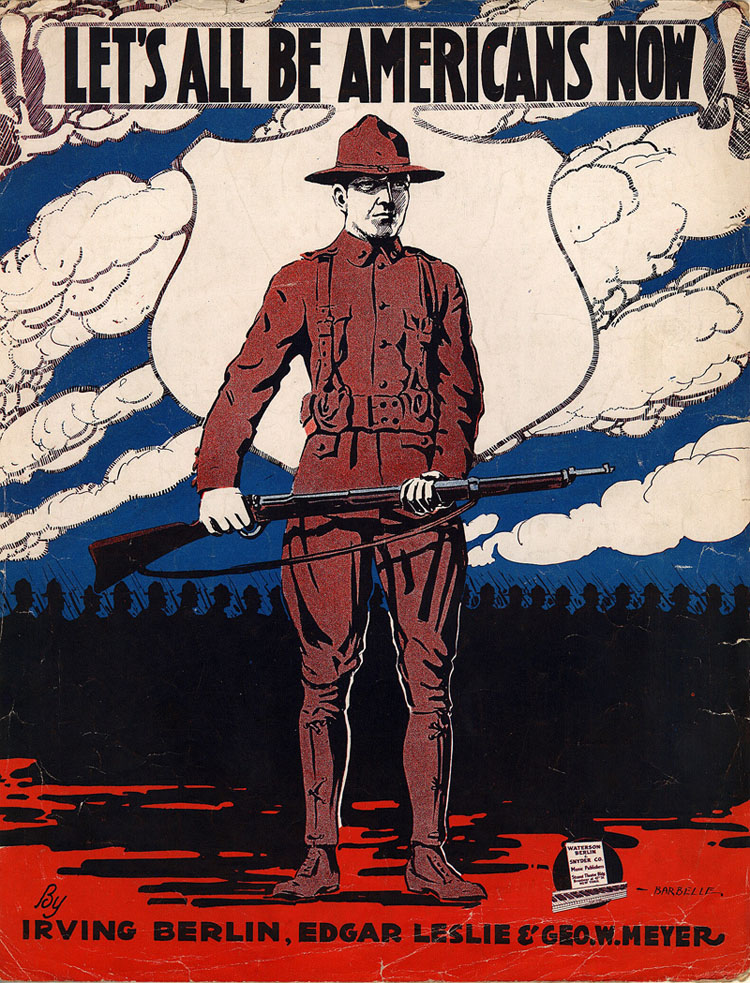
"Let's All Be Americans Now"
by Berlin, Leslie and Meyer; Published by Waterson, Berlin and Snyder,
New York, 1917 (Courtesy Duke
University Libraries - David M. Rubenstein Rare Book and Manuscript
Library)
When the record "Let's All Be Americans
Now" was recorded on February 28, 1917 the United States had
not yet declared war. One of the lyrics of the song included the possibility
that "England or France may have your sympathy, -- or Germany."
But "now is the time" "Let's all be Americans Now."
"Now there's trouble in the
air, War is talked of ev'ry where,...We're not looking for any kind
of war, but if we fight we must
It's up to you! What will you do?
England or France may have your sympathy, -- or Germany
But you'll agree that, now is the
time, To fall in line...You swore that you would, so be true to
your vow, Let's all be Americans Now."

"Let's
All Be Americans Now" performed by Adolph J. Hahl (Arthur
Hall), Edison Domestic series 3201, 4-minute Edison Blue Amberol Record,
recorded February 28, 1917 (Courtesy of i78s.org
)
On February 1, 1917 Germany returned
to its policy of unrestricted submarine warfare. On April 6, 1917
the United States declared war on Germany.
When war on Germany was declared by
the United States the phonograph industry responded with support,
patriotism, and related songs and thematic promotional material. Claude
and his band of new brothers had a few thoughts about the Kaiser:
If they talked about the war, or
the enemy they were getting ready to fight, it was usually in a
facetious tone; they were going to "can the Kaiser," or to make
the Crown Prince work for a living. Claude loved the men he trained
with,—wouldn't choose to live in any better company. (p. 333)
Wanting to "make the Crown Prince
work for a living" was also expressed as wanting the Kaiser to
be in hock or "Hock the Kaiser" (as Bert
Williams sang in his record "I'm Neutral" when he said
"there ain't no use in talkin" but "somebody hocked
the Kaiser and I don't know the reason why."
"Can" the Kaiser and other
messages to the Kaiser
This motion toy phonograph attachment
featured Uncle Sam booting, kicking, and "canning" Kaiser
Bill who is running away carrying his U-Boat "Pretzel."

The National Toy Co., “Play
with any Lively or Patriotic Record.” The Talking Machine World,
May 1917
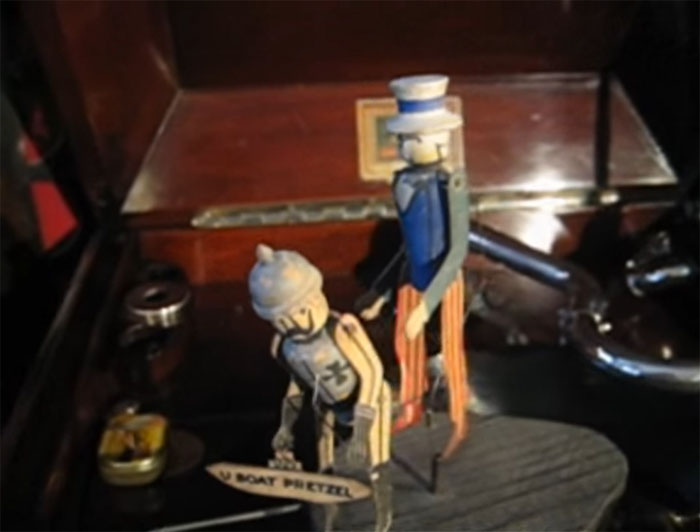
Watch
Uncle Sam "boot" Kaiser Bill to Sousa's "Under
the Double Eagle March" (30 second extract courtesy of CURIOSITYPHONO)

"Can the Kaiser" by Adkins
& Fennell, Published by Adkins-Fennell Music Co., Kansas City,
MO, 1917 (Courtesy Library of
Congress)

"They're on their way to Kan the
Kaiser" by Pyle and Thomas. Published by Thomas & O'Connell
Music Pub. Co., New York City, 1917 (Courtesy
The
Lester S. Levy Collection of Sheet Music)

"Can the Kaiser, Yankees"
by Tom Williams, Published by Tom Williams, Philadelphia, PA, 1917
(Courtesy Library of Congress)
Nipper and "His Master's Voice"
were adapted into war-time parodies and propoganda.

Postcard circa 1917 (PM-2048)

Postcard circa 1914 (PM-0414)

Postcard circa 1916 (PM-0356)

THE DACHSHUND:
"I thought you were only a contemptible little talking machine."
(Source: The Bystander,
October 7, 1914, Mary
Evans Picture Library)

Political Cartoon published
in 1916 regarding Flemish newspaper purchased by Germany during World
War I (6A)

"His Master's Voice,"
April 20, 1918, US
National Archives, Berryman Political Cartoon Collection

The Montreal Daily Star, October
15, 1918 as reprinted in The Talking Machine World, November
15, 1918 depicting in a cartoon the recent correspondence between
President Wilson and the German Government regarding an armistice.

The Talking Machine
World, May 1917

"We're All Going Calling
on the Kaiser" by Caddigan and Brennan, publisher Leo. Feist, Inc.
New York (Courtesy of Giovannoni-Sheram
Collection i78s.org)

"We're
All Going Calling on the Kaiser" sung by Arthur Fields and
Peerless Quartette, Columbia Record A2569, Recorded May 13, 1918
(Courtesy of i78s.org)
Investigation of pro-German propaganda
using phonograph records

"Canned
Propaganda," The Talking Machine World, March 15,
1918
VALLORBES NEEDLES
"MOBILIZED
in the SERVICE of OUR COUNTRY"

The Talking Machine
World, June 15, 1918 (Click image to see full ad)

Cover of Trade Journal
The Voice of the Victor, October 1918.

"Songs Across the Sea" and
the "the music of liberty." The Ladies' Home Journal
for January, 1919
Submarine Warfare
There are a number of references to
the German submarine threat and its impact on the war starting with
Germany's resumption of "unrestricted submarine warfare."
...indeed, until the announcement
that Germany would resume unrestricted submarine warfare made every
one look questioningly at his neighbour. (p. 304)

German submarine crew playing
music and listening to gramophone, postcard ca. 1915 (PM-0675)
Germany's announcement of unrestricted
warfare on all ships would be a major impetus for the United States
to finally enter the war. Once war was declared on Germany the former
neutrality and even support of Germany by Americans vanished and the
many of the German immigrants in Nebraska who were former friends
and neighbors were transformed into potential informants or saboteurs.
Literally reflecting this change of heart, names of cities and businesses
were changed. Historian Jim McKee summarizes some of these changes
in Nebraska as follows:
Lincoln's German-American Bank
became Continental National Bank, Schmidts became Smiths, Gov. Charles
Dietrich's German National Bank of Hastings became the Nebraska
National Bank, while the town of Berlin became Otoe and Germantown
in Seward County was renamed Garland for Ray Garland, who was killed
in France in 1918. (4)
McKee then notes that
"in the hasty renaming of Berlin, it was probably not even named
in honor of the German city but for E.D. Berlin, a local farmer.

This 1918 era photo shows a Lincoln
parade with its obvious anti-German sentiments illustrated in the
"To hell with the the bier-like wagon saying, "Liberty Day." Jim
McKee, The Lincoln Journal, June 27, 2010 (Photo courtesy
of Kent Remenga).
Submarine Warfare (Continued)

Description from the Edison record
sleeve of Edison Record No. 50490, Submarine Attack (Courtesy
of i78s.org)

Submarine
Attack by Theodore Morse
performed by Premier Quartet and Company, Edison Diamond Disc Re-Creation
Record No. 50490 (Courtesy of i78s.org)

"The
Submarine Attack Somewhere
at Sea" Sung
by Peerless Quartette, Columbia Grafonola A2626, Recorded February
27, 1918 (Courtesy Library of
Congress)

"Good Bye Kaiser Bill" by
J. L. Waldorf, Published by J. L. Waldorf,, Centerburg, OH 1918 (Courtesy
Library of Congress)
Additional references to German submarines
in One of Ours.
"Here's one naval authority
who says the Germans are turning out submarines at the rate of three
a day. They probably didn't spring this on us until they had enough
built to keep the ocean clean." (p. 306)
A second witness had heard Oberlies
say he hoped the German submarines would sink a few troopships;
that would frighten the Americans and teach them to stay at home
and mind their own business. (p.
321)
Claude's mother was extremely anxious
about Claude and the other soldiers being able to safely cross the
ocean because of the German submarines.
"I hardly see how we can bear the
anxiety when our transports begin to sail," she said thoughtfully.
"If they can once get you all over there, I am not afraid; I believe
our boys are as good as any in the world. But with submarines reported
off our own coast, I wonder how the Government can get our men across
safely. The thought of transports going down with thousands of young
men on board is something so terrible—" she put her hands quickly
her eyes. (pp. 341-342)
"Absolutely. The British are depending
on their aircraft designers to do just that, if everything else
fails. Of course, nobody knows yet how effective the submarines
will be in our case." (p. 343)
"Lieutenant, I wish you'd explain
Lieutenant Fanning to me. He seems very immature. He's been telling
me about a submarine destroyer he's invented, but it looks to me
like foolishness."(p. 365)
In popular culture one of the three
World War I patriotic "Talking Books" put out in June 1919
by the Talking Book Corporation was "Submarine Attack."

The Talking Machine
World, June 15, 1919
The Talking Book Corporation was one
of the companies owned by Victor Hugo Emerson who was the founder
of the Emerson Phonograph Company and Emerson
Records. Violinist David Hochstein recorded for Emerson Records.
Submarine Attack
- A "Talking" Book

Submarine Attack A "Talking"
Book made by The Talking Book Corporation, Emerson Records, 1919
(FP1286)
The book is opened and the book's page
with the record on it is placed on the phonograph's platter. Listen
to SUBMARINE ATTACK on this record.

The Talking Book Corporation, Emerson
Records, 1919 (Video courtesy of Bruce
Victrolaman Young)
Submarine Attack A "Talking"
Book (back cover)

Submarine Attack a
"Talking" Book page 2 (FP1286A)

We'll knock that little "U-boat"
high and dry, words by
Alice D. Elfreth, Music by Al. Franz, Published by Alice D. Elfreth,Philadelphia,
Pa., 1917, monographic. (Courtesy
Library
of Congress)
The Marne
The Allied success at the First Battle
of the Marne in 1914 saved Paris from being taken by the Germans.
Marne is referenced throughout the book for its strategic victory
but also for its lasting memory as its name "had come to have
the purity of an abstract idea" and everyone in France seemed
to have a connection to it.
Claude squirmed, as he always did
when his mother touched upon certain subjects. "Well, you see, I
can't forget that the Germans are praying, too. And I guess they
are just naturally more pious than the French." Taking up the book
he began once more: "In the low ground again, at the narrowest part
of the great loop of the Marne," etc. (p. 230)
"The French have stopped falling
back, Claude. They are standing at the Marne. There is a great battle
going on. The papers say it may decide the war. It is so near Paris
that some of the army went out in taxi-cabs." (p. 231)
It was curious, he reflected, lying
wide awake in the dark: four days ago the seat of government had
been moved to Bordeaux,—with the effect that Paris seemed suddenly
to have become the capital, not of France, but of the world! He
knew he was not the only farmer boy who wished himself tonight beside
the Marne. The fact that the river had a pronounceable name, with
a hard Western "r" standing like a keystone in the middle of it,
somehow gave one's imagination a firmer hold on the situation. Lying
still and thinking fast, Claude felt that even he could clear the
bar of French "politeness"—so much more terrifying than German bullets—and
slip unnoticed into that outnumbered army. One's manners wouldn't
matter on the Marne tonight, the night of the eighth of September,
1914. There was nothing on earth he would so gladly be as an atom
in that wall of flesh and blood that rose and melted and rose again
before the city which had meant so much through all the centuries—but
had never meant so much before. Its name had come to have the purity
of an abstract idea. In great sleepy continents, in land-locked
harvest towns, in the little islands of the sea, for four days men
watched that name as they might stand out at night to watch a comet,
or to see a star fall. (pp. 232-233)
As she went about these tasks, she
prayed constantly. She had not prayed so long and fervently since
the battle of the Marne. (p. 249)
Yet here they were. And in this
massing and movement of men there was nothing mean or common; he
was sure of that. It was, from first to last, unforeseen, almost
incredible. Four years ago, when the French were holding the Marne,
the wisest men in the world had not conceived of this as possible;
they had reckoned with every fortuity but this. Out of these stones
can my Father raise up seed unto Abraham. (p. 377)
Something was released that had
been struggling for a long while, he told himself. He had been due
in France since the first battle of the Marne; he had followed false
leads and lost precious time and seen misery enough, but he was
on the right road at last, and nothing could stop him. (p. 412)
And her father? He was dead; mort
è la Marne, en quatorze. "At the Marne?" Claude repeated, glancing
in perplexity at the nursing baby. (p. 476)
When Owens was in college he had
never shown the least interest in classical studies, but now it
was as if he were giving birth to Caesar. The war came along, and
stopped the work on his dam. It also drove other ideas into his
exclusively engineering brains. He rushed home to Kansas to explain
the war to his countrymen. He travelled about the West, demonstrating
exactly what had happened at the first battle of the Marne, until
he had a chance to enlist.
In the Battalion, Owens was called
"Julius Caesar," and the men never knew whether he was explaining
the Roman general's operations in Spain, or Joffre's at the Marne,
he jumped so from one to the other. Everything was in the foreground
with him; centuries made no difference. Nothing existed until Barclay
Owens found out about it. (pp. 486-487)
Claude thought he would stroll about
to look at the town a little. It had been taken by the Germans in
the autumn of 1914, after their retreat from the Marne, and they
had held it until about a year ago, when it was retaken by the English
and the Chasseurs d'Alpins . They had been able to reduce it and
to drive the Germans out, only by battering it down with artillery;
not one building remained standing. (p. 500)
He told her about his mother and
his father and Mahailey; what life was like there in summer and
winter and autumn—what it had been like in that fateful summer when
the Hun was moving always toward Paris, and on those three days
when the French were standing at the Marne; how his mother and father
waited for him to bring the news at night, and how the very cornfields
seemed to hold their breath.
Mademoiselle Olive sank back wearily
in her chair. Claude looked up and saw tears sparkling in her brilliant
eyes. "And I myself," she murmured, "did not know of the Marne until
days afterward, though my father and brother were both there! I
was far off in Brittany, and the trains did not run. (p. 513)

Stereoview card published 1919. Ruins
of Marne Bridge. After the Germans were defeated on the Marne in 1914
they blew up this bridge in their "hasty retreat to hamper the
pursuing French."
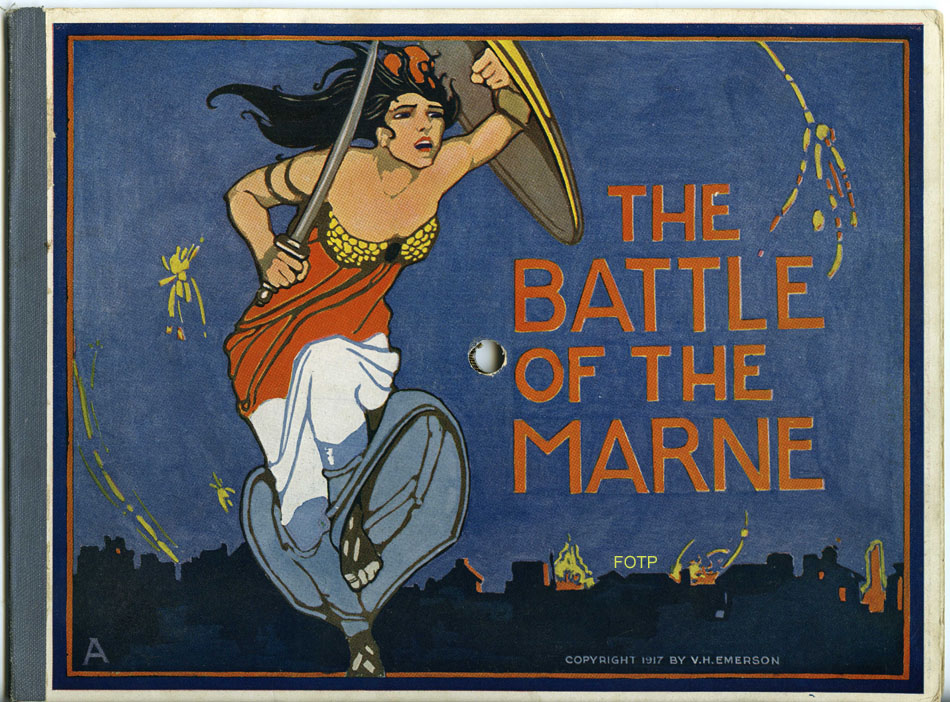
The Battle of the Marne - A
"Talking" Book, by V. H. Emerson and the Talking Book
Corporation, 1917 (FP1480)

The Battle of the Marne - A "Talking"
Book, by V. H. Emerson and the Talking Book Corporation, 1917 (FP1480)

The Battle of the Marne - A "Talking"
Book, by V. H. Emerson and the Talking Book Corporation, 1917 (FP1480)
"Let us listen
to the Story! Let us sing the Marseillaise!"

La Mareillaise by Etienne Drian in Gazette
du bon ton: Arts, modes & frivolités. Paris:
Lucien Vogel, Summer 1915. La Marseillaise illustration and
the following text are from En Guerre, French Illustrators and
World War I by Neil Harris and Teri J. Edelstein, University of
Chicago Library, 2014, p. 102)
An editorial in the Gazette du
bon ton in the summer of 1915 declared "that because France
has just escaped the greatest peril and is proceeding toward certain
victory, the magazine could be published." The authors then
noted that "most of the illustrations contain no hint of war."
However, a series by Etienne Drian did: "Fashionably dressed
women engage in patriotic activities: arranging a tricolor bouquet,
reading the war news, following a battle map, or listening to the
Marseillaise."

"La
Marseillaise" (de Lisle) {In English}, performed by Thomas
Chalmers, Edison Concert series 28289, 4-minute Edison Blue Amberol
Record, recorded May 21, 1917 (Courtesy i78s.org)
"The Marseillaise is worth
a million men to France."

Edison Message No. 26,
The Talking Machine World, September 15, 1918
Battle of the Marne War Song

"They Shall Not Pass (Battle of
the Marne War Song)" Sheet
music contributor names Schasberger, Otto C. (composer) Muchmore,
Henry E. (lyricist) Published by Music Printing Co., New York, 1918
(Courtesy Library of Congress)

"Battle of the Marne March"
by J. Luxton, published by Church,
Paxson, & Co., New York, 1916 (Courtesy
Smithsonian
Libraries)

"Battle
of the Marne March" by J. Luxton on 4-minute Edison Amberola
Record No. 3018 performed by Sodero's Band (as New York Military Band)
Cesare Sodero, director, recorded April 20, 1916 (Courtesy i78s.org)

"Battle
of the Marne" Descriptive by J. Luxton played by the New
York Military Band on Edison Diamond Disc Record 50422, 1917 and available
on Internet
Archive.

"The
Battle of the Marne" performed by Russell Hunting, Elocutionist,
on Pathe 12" Record No. 35067, double-sided disc (Courtesy of
i78s.org)

"We
stopped them at the Marne," performed by Premier Quartet
, Edison Domestic series 3525, 4-minute Edison Blue Amberol Record,
recorded April 23, 1918 (Courtesy of i78s.org)

"Spirit of France March" by
E. T. Paull, Published by E. T.
Paull Music Co., New York, 1919
Foch's Message to Joffre at the Battle
of the Marne: "My right
wing is retreating. My left wing is broken, I am attacking with the
center." (Courtesy The
University of South Carolina and the Joseph M. Bruccoli Great
War Collection)
Claude Prepares for France
Claude had studied French in school
and thought he knew it well enough to even be able to slip into their
army to help save Paris if he would have been in France at the time.
And when he did enlist and finished his basic training and was going
home before shipping off to France he would continue to study his
French. Most of the American doughboys didn't know French. The French
phrase book "made up of sentences chosen for their usefulness
to soldiers" was one solution.
"I surely never wore anything else
in the month of July," Claude admitted. "When I find myself riding
along in a train, in the middle of harvest, trying to learn French
verbs, then I know the world is turned upside down, for a fact!"
The old man pressed a cigar upon him and began to question him.
Like the hero of the "Odyssey" upon his homeward journey, Claude
had often to tell what his country was, and who were the parents
that begot him. He was constantly interrupted in his perusal of
a French phrase book (made up of sentences chosen for their usefulness
to soldiers,—such as, "Non, jamais je ne regarde les femmes") by
the questions of curious strangers. (pp. 326-327)
The phonograph industry offered another
way "for the use of Army Men in France besides a French phrase
book:" French language courses, e.g., Cortina's Phone-Method,
Victor's French Record Course, and others.
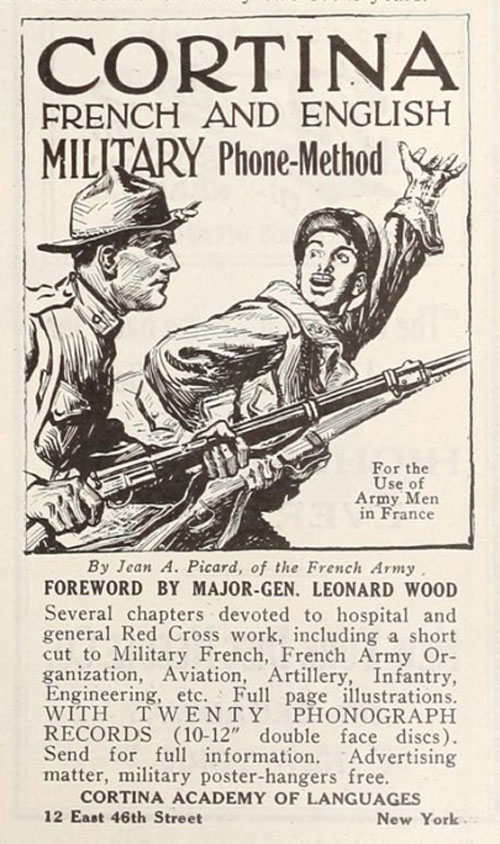
The Talking Machine
World, August 1917, p. 111

"Victor French Course in Demand
- Represents a Timely Contribution to the War Needs of the Country
From the Talking Machine Trade — Being Strongly Featured," headline
of article in The Talking Machine World, January
1918, p. 68

Original Poster (24.75"
X 37") Courtesy of Heritage
Auctions ©2018

When
Yankee Doodle Learns to "Parlez Vous Francais," by Hart
& Nelson, A.J. Stasny Music Co., New York, 1917

When
Yankee Doodle Learns to "Parlez Vous Francais,"
sung by Arthur Fields, 4-minute
Edison Amberola Record No. 3447, Recorded on December 4, 1917 (Courtesy
i78s.org)
Camp Dix, New Jersey
Gerhardt rolled over on his back
and put his hands under his head. "Oh, this affair is too big for
exceptions; it's universal. If you happened to be born twenty-six
years ago, you couldn't escape. If this war didn't kill you in one
way, it would in another." He told Claude he had trained at Camp
Dix, and had come over eight months ago in a regimental band, but
he hated the work he had to do and got transferred to the infantry.
(p. 466)
David Gerhardt trained at Camp Dix and
played in regimental band.
Listening to the Victrola
at Camp Dix, New Jersey

"In Camp or Trench, on transport
or battleship...the Victrola is the unflagging, and often the only
source of music and entertainment." The
Talking Machine World, July 15, 1918

Dutch Officers listening to the phonograph.
RPPC ca.1915 (PM-0369) The Netherlands remained neutral throughout
World War I.

Life in the U. S. Army
Cantonment. Postcard ca.1918 (PM-0368)

Gathering Around the Phonograph.
Postcard ca.1919 (PM-0357)

"The Victrola is in active service
doing its musical duty..bringing joy to the hearts of the soldier
and sailor boys in camp." The Ladies' Home Journal, November
1918 (PM-2138)
"Good Bye Broadway, Hello France"

The National Geographic
Magazine, February 1918
As Claude and the troops stood on the
deck of their ship leaving the port of New York City Claude saw its
profile in the mist and there was disappointment as the tall buildings
"looked unsubstantial and illusionary' and no one knew what buildings
they were even looking at. They didn't get their day in the city and
now they were leaving for Paris and had "never so much as walked
up Broadway."
By seven o'clock all the troops
were aboard, and the men were allowed on deck. For the first time
Claude saw the profile of New York City, rising thin and grey against
an opal-coloured morning sky. The day had come on hot and misty.
The sun, though it was now high, was a red ball, streaked across
with purple clouds. The tall buildings, of which he had heard so
much, looked unsubstantial and illusionary,—mere shadows of grey
and pink and blue that might dissolve with the mist and fade away
in it. (p. 361)
They agreed it was a shame they
could not have had a day in New York before they sailed away from
it, and that they would feel foolish in Paris when they had to admit
they had never so much as walked up Broadway. (p. 361)

"Good-Bye Broadway, Hello France"
by Reisner and Davis, Music by Baskette, Published by Leo. Feist,
Inc., New York 1917 (Courtesy
of i78s.org)

"Good
Bye Broadway, Hello France" Sung by Peerless Quartette, Columbia
Record A2333, Recorded on July 16, 1917 in New York City. (Courtesy
Library of Congress)

"Good
Bye Broadway, Hello France" Sung by Arthur Fields. Edison
Domestic Series 3321, 4-minute celluoid cylinder, recorded July 17,
1917 (also dubbed on Edison Diamond Disc Record). (Courtesy
of i78s.org)


"Departure
of the American Troops for France" by Prince's Band and Columbia
Male Quartette Record A2354 (Courtesy
of i78s.org) and the Internet
Archive)

"Departure
of the First U.S. Troops for France" by Russell Hunting,
Pathé 20125 (Courtesy of
i78s.org)

"When Alexander Takes His Ragtime
Band to France," by Bryan, Hess & Leslie, Published by Waterson,
Berlin & Snyder Co., 1918 (Giovannoni-Sheram Collection)
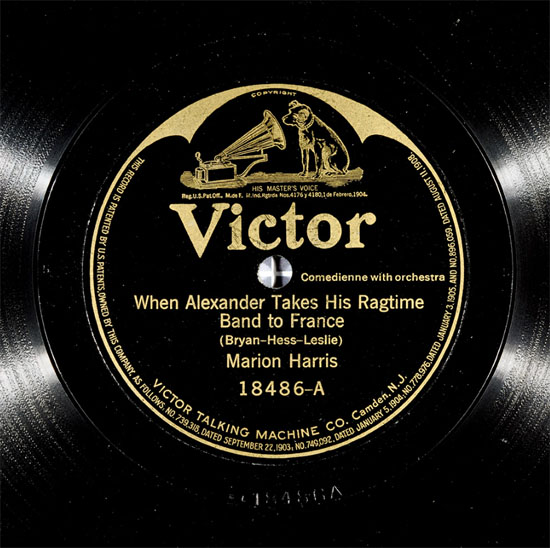
"When
Alexander Takes His Ragtime Band To France" by Marion Harris,
Victor Record No. 18486-A, 1918 (Courtesy of i78s.org)
The Statue of Liberty
Claude and the troops stood on the deck
of their ship leaving New York City and "sliding down toward
the point and getting their "first glimpse of the Bartholdi statue:"
"There she is!" "Hello, old girl!"
"Good-bye, sweetheart!"
The swarm surged to starboard. They
shouted and gesticulated to the image they were all looking for,—so
much nearer than they had expected to see her, clad in green folds,
with the mist streaming up like smoke behind. For nearly every one
of those twenty-five hundred boys, as for Claude, it was their first
glimpse of the Bartholdi statue. Though she was such a definite
image in their minds, they had not imagined her in her setting of
sea and sky, with the shipping of the world coming and going at
her feet, and the moving cloud-masses behind her. Post-card pictures
had given them no idea of the energy of her large gesture, or how
her heaviness becomes light among the vapourish elements. "France
gave her to us," they kept saying, as they saluted her. (p. 362)

"L-i-b-e-r-t-y" by Ted S.
Barron, published by Metropolis Music Co., New York, 1916 (Courtesy
Duke University Libraries)

"L-i-b-e-r-t-y"
by Henry Burr, Rex 10" Record No. 5377-A, produced 1914-1917
(Courtesy of i78s.org)

The Talking
Machine World, November 1917
"Over There"
Claude and the troops standing on the
deck of their ship leaving the port of New York City:
Before Claude had got over his first
thrill, the Kansas band in the bow began playing "Over There." Two
thousand voices took it up, booming out over the water the gay,
indomitable resolution of that jaunty air. (p. 363)

"Over
There" by Enrico Caruso, Victor Record 87294, recorded on
July 11, 1918 (Courtesy of i78s.org)

(Courtesy of i78s.org)

"OVER THERE" U.S. Navy
Recruitment Poster by Albert Sterner 1917. Sailor being sent to battle
by a symbolic female figure with sword, possibly Liberty. (Library
of Congress)
The Voyage of the Anchises
- "Long, Long Ago"
That evening Claude was on deck,
almost alone; there was a concert down in the ward room. To the
west heavy clouds had come up, moving so low that they flapped over
the water like a black washing hanging on the line. p. 376
The music sounded well from below.
Four Swedish boys from the Scandinavian settlement at Lindsborg,
Kansas, were singing "Long, Long Ago." Claude listened from a sheltered
spot in the stern. What were they, and what was he, doing here on
the Atlantic? p. 376
"Long, Long Ago": This nostalgic English
popular song was written by Thomas Harnes Bayly and was first published
as "The Long Ago" in 1833. (Explanatory Note 376, One of Ours
Scholarly Edition)

"Long,
Long Ago" Irish Ballad by Mr. Frank S. Maszziotti, Piccolo,
7" Disc Zon-o-phone Record 9097 (pre-1903)

"Long,
Long Ago" by Frieda Hempel, Recorded 12/31/1917, New York,
Edison 82550 10-in. (UCSB Library, DAHR)
The Voyage of the Anchises
- "Annie Laurie"
Downstairs the men began singing
"Annie Laurie." Where were those summer evenings when he used to
sit dumb by the windmill, wondering what to do with his life? p.
377
"Annie Laurie": This popular nineteenth-century
song by Lady John Dunlop Scott was based on a poem by William Douglas.
The verses express the sadness of lost love, as the speaker has discovered
that Annie has married another man. (Explanatory Note 377, One
of Ours Scholarly Edition)

"Annie Laurie"
sheet music cover, unknown date (Courtesy Cleveland
Museum of Art)

"Annie
Laurie" sung by Louise Homer, Victor Red Seal Record 87206,
Recorded 5/27/1914 Camden, New Jersey (i78s.org) (Label Courtesy Stanford
Libraries)

"They All Sang Annie Laurie,"
Words by J. Will Callahan, Music by F. Henri Klickmann, Publisher
Frank K. Root & Co., New York, 1915
Claude's Ship Arrives in France
Something caught his eye through
the porthole,—a great grey shoulder of land standing up in the pink
light of dawn, powerful and strangely still after the distressing
instability of the sea. Pale trees and long, low fortifications
. . . close grey buildings with red roofs . . . little sailboats
bounding seaward . . . up on the cliff a gloomy fortress. He had
always thought of his destination as a country shattered and desolated,—"bleeding
France"; but he had never seen anything that looked so strong, so
self-sufficient, so fixed from the first foundation, as the coast
that rose before him. It was like a pillar of eternity. The ocean
lay submissive at its feet, and over it was the great meekness of
early morning. (p. 422)

The Talking Machine
World, October 1917
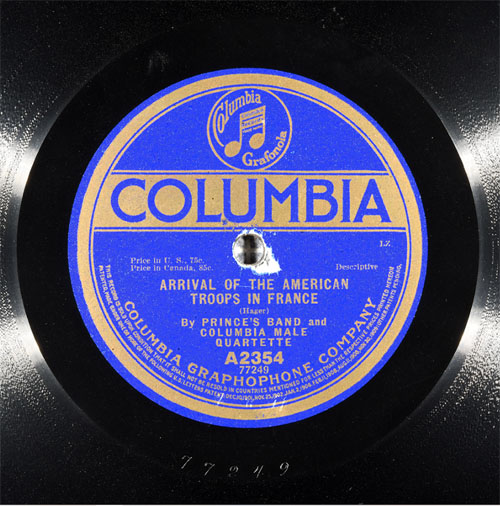
"Arrival
of the American Troops in France" by Prince's Band and Columbia
Male Quartette Record A2354 (Courtesy of i78s.org)
and the Internet
Archive)

"The
Americans Come!" by Reinald Werrenrath, Victor Record 45157-A,
Recorded October 28, 1918 (Courtesy
of i78s.org)

Visit
BritishPathé to watch Arrival of American Troops In France
1917 - ©PATHE

Barricade in Streets
of Eclusiers, France. Stereoview card 1918 (PM-1886)
"Roses of Picardy"
With Victor and Claude having dinner
at the Grand Hotel in Dieppe, France, and with Victor heading out
to Verdun the next day, Victor is gloomy when answering about when
he'll next see Maisie in London, and starts whistling "Roses
of Picardy."
God knows," Victor answered gloomily.
He looked up at the ceiling and began to whistle softly an engaging
air. "Do you know that? It's something Maisie often plays; 'Roses
of Picardy.' You won't know what a woman can be till you meet her,
Wheeler." (p. 436)

"Roses
of Picardy "Sung by John McCormack, Victrola Red Seal Record
748-A, Recorded April 16, 1919 (Courtesy
DAHR and Library of Congress)
General John J. Pershing
General Pershing was the U.S. Army general
who commanded the American Expeditionary Force (AEF) in Europe during
World War I.
Years ago, when General Pershing,
then a handsome young Lieutenant with a slender waist and yellow
moustaches, was stationed as Commandant at the University of Nebraska,
Walter Scott was an officer in a company of cadets the Lieutenant
took about to military tournaments. The Pershing Rifles, they were
called, and they won prizes
wherever they went. After his graduation, Scott settled down to
running a hardware business in a thriving Nebraska town, and sold
gas ranges and garden hose for twenty years. About the time Pershing
was sent to the Mexican Border, Scott began to think there might
eventually be something in the wind, and that he would better get
into training. He went down to Texas with the National Guard. He
had come to France with the First Division, and had won his promotions
by solid, soldierly qualities. (p. 453)

General Pershing Decorating Officers
of 89th Div., Treves, Germany. Stereoview card 1918 (PM-1883)

Hear the words from General John J.
Pershing "From
the Battlefields of France," The Columbia Graphophone Co.,
1918 (Courtesy of i78s.org)

Edison Message No. 29,
The Talking Machine World, October 15, 1918

"A PERSHING PATRIOT!" Buy
War Savings Stamps, poster by R.H. Sommer, Illinois Litho. Co., 1918
(Library of
Congress)

British troops in World War I from "They
Shall Not Grow Old" by Peter Jackson (Courtesy Warner Bros. Pictures,
©2018)
One of John Philip Sousa's fears in
his 1906 article "The Menace of Mechanical Music" was that
military music would be replaced by phonograph records:
Shall we not expect that when the
nation once more sounds its call to arms and the gallant regiment
marches forth, there will be no majestic drum major, no serried
ranks of sonorous trombones, no glittering array of brass, no rolling
of drums? In their stead will be a huge phonograph, mounted on a
100 H. P. automobile, grinding out "The Girl I left Behind Me,"
"Dixie," and "The Stars and Stripes Forever."

"The
Menace of Mechanical Music" by John
Philip Sousa, Appleton's
Magazine,
September 1906

"General
Pershing March" played by Victor Band, Record 18607-A, Recorded
on August 5, 1919 (Courtesy of
i78s.org)

Respectfully Dedicated
to General John J. Pershing
"Hats off to the Red White and
Blue," Words by Chester R. Hovery. Music by Ralph F. Beegan.
Publisher Jerome H. Remick & Co., Detroit, 1918 (Source: The
Lester S. Levy Collection of Sheet Music)
In the Trenches and No Man's Land
FOUR o'clock . . . a summer dawn
. . . his first morning in the trenches. Claude had just been along
the line to see that the gun teams were in position. This hour,
when the light was changing, was a favourite time for attack. He
had come in late last night, and had everything to learn...
That dull stretch of grey and green
was No Man's Land. Those low, zigzag mounds, like giant molehills
protected by wire hurdles, were the Hun trenches; five or six lines
of them. He could easily follow the communication trenches without
a glass...
Their own trenches, from the other
side, must look quite as dead. Life was a secret, these days....
It all took place in utter darkness.
Just as B Company slid down an incline into the shallow rear trenches,
the country was lit for a moment by two star shells, there was a
rattling of machine guns, German Maxims,—a sporadic crackle that
was not followed up. Filing along the communication trenches, they
listened anxiously; artillery fire would have made it bad for the
other men who were marching to the rear. But nothing happened. They
had a quiet night, and this morning, here they were! (pp.478-479)

"The Rose of No Man's Land"
by Jack Caddigan and James A. Brennan. Published by Jack Mendelsohn
Music Co., Boston, 1918 (Courtesy
The
Lester S. Levy Collection of Sheet Music)

"The
Rose of No Man's Land" by Moonlight Trio, Edison Domestic
Series 3677, 4-minute celluoid cylinder, recorded October 11, 1918
(Courtesy of i78s.org)

"The
Midnight Attack," Played by Prince's Band, Columbia Record
A1339, Recorded April 16, 1913 (Courtesy
Library of Congress)

"The Boys in Khaki
are in the Trenches," The Talking Machine World, July 1917
"Caruso is singing
in the trenches"

“Caruso is singing in the trenches
of France tonight…Thousands of miles from home in a land torn
by battle, our boys yet listen to the spiritual voice of Art. Through
the Victrola, the mightiest arts in all the world sing to them the
hymn of victory, cheer them with their wit and laughter, comfort and
inspire them.” Victrola ad, The Theatre Magazine, November
1918 (PM-1944)
Listen
to Enrico Caruso singing "Over There."
Listen
to Alma Gluck singing "Home, Sweet Home."
Listen
to John McCormack singing "Roses of Picardy."

The Wizardry of the Aeolian-Vocalian
Phonograph can "summon his very presence" from the fields
of France, Aeolian-Vocalion 1917



Watch
Trailer for "They Shall Not Grow Old"
by Peter Jackson for a haunting time travel experience to World War
I (Courtesy Warner Bros. Pictures, ©2018)

"His Master's
Voice" 12" 78 RPM record by the Gramophone Co., Ltd.,
1918
This record from ValueYourMusic
website was submitted by Allen Koenigsberg who also cautioned that
"there may be some controversy over the circumstances of this
recording."
The record is said to be the actual
recording of gas shell bombardment by the Royal Garrison Artillery,
9th October 1918, preparatory to the British Troops entering Lille
and "the only authentic sounds of the First World War."
"This record was made by
HMV’s top Recording Engineer, Will Gaisberg, outside Lille in France
on 9th October 1918 and rushed back to England for issue, but by
the time it saw release the Armistice had been signed and, consequently,
sales were very poor." (ValueYourMusic.)
According to The
Church of the Epiphany, "by the time the recording was
completed, the war was over. Gaisberg had been slightly gassed during
the expedition, and fell victim to the flu pandemic and tragically
died a month later" on 5 November 1918.
Aeroplanes and Victor Morse
Claude said he had a friend in the
air service up there; did they happen to know anything about Victor
Morse?
Morse, the American ace? Hadn't
he heard? Why, that got into the London papers. Morse was shot down
inside the Hun line three weeks ago. It was a brilliant affair.
He was chased by eight Boche planes, brought down three of them,
put the rest to flight, and was making for base, when they turned
and got him. His machine came down in flames and he jumped, fell
a thousand feet or more.
"Then I suppose he never got his
leave?" Claude asked.
They didn't know. He got a fine
citation. (p. 493)

French Fliers Ready
for Action On the Battle Line. Stereoview card 1918 (PM-1892)
A multiple-degrees of separation connection
with the phonograph and air service personnel in the US military is
made with Scientific American's February 20, 1915 cover illustration
and story "The Phonograph Leaves the Air Scout's Hands Unhampered."
A phonograph is pictured with the observer in the aeroplane looking
through his binoculars with one hand while the other hand is writing
down information and the phonograph ready for dictation.
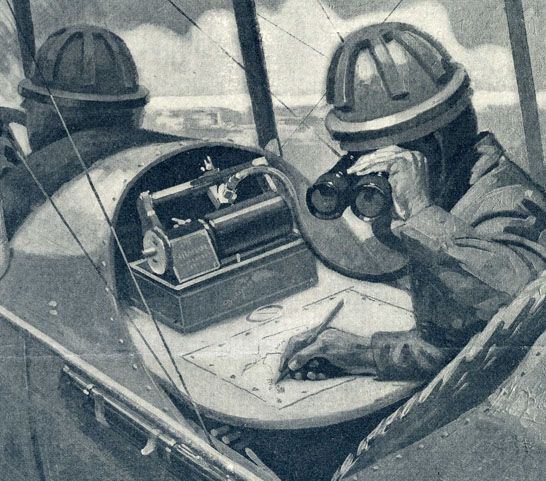
The Phonograph Aids
the Aeroplane Air Scouts, Scientific American (PM-2064)
The article inside, titled "Mechanical
Aids for Air Scouts," explains "in carrying out scouting
observations with military aeroplanes it is essential that there be
two men in the machine, namely, a pilot whose sole duty it is to operate
and steer the craft, and an observer who can devote undivided attention
to scanning the ground below him and making sketches of fortified
works, the disposition of the enemy's guns, the movements of their
troops, and the like...If the observer is to make sketches of the
ground over which he is flying, he will be some much occupied, probably,
as to not to have time to jot down notes...a phonograph is now provided,
with a speaking tube running to the observer's mouth, so that he may
talk into the machine at any time during the flight and thus make
a record of his observations..."

Scientific American
(PM-2064)
Support for the Troops
"In camp or trench, on transport
or battleship, in hospital, church and cantonment...the Victrola is
enlisted in the War for Democracy." "Every Victrola in the
service of Uncle Sam is a source of actual war strength." Victrola
Ad, The Talking Machine World, July 15, 1918
“A Church Service On The Battlefield"
Russell Hunting performed this descriptive
record for Pathé Frères Phonograph Co. of a church service
for United Kingdom troops on the battlefield with Rock of Ages,
a prayer and then a bugle call in response to an imminent attack.

"A
Church Service On the Battlefield," Pathé Record 35067
is Side B of "The Battle of the Marne," 1917 (Courtesy of
i78s.org)
Record Bulletins for
January 1918

The Talking Machine World,
December 1917 Pathe Record (Composer is John Greenleaf Whittier)

The Talking Machine
World, January 15, 1918

The Talking Machine
World, January 15, 1918


The Talking Machine
World, January 15, 1918

"They All Sang Annie Laurie,"
Words by J. Will Callahan, Music by F. Henri Klickmann, Publisher
Frank K. Root & Co., New York, 1915

The Talking Machine
World, March 15, 1918
"Victrolas and Victor Records are
day and night advancing the cause of freedom on the battlefields of
the entire world...Every Victor Record at the front is a winged messenger
of victory..."

The Talking Machine
World, July 15, 1918

"Do Your Little "Bitty
Bit" (Right Now!)" by F. Belohlavek and C.C. Perkins.
Music by Edmund Braham. The Frances-Clifford Music Publishing
Co., Chicago, 1917. (Source: The
Lester S. Levy Collection of Sheet Music)

LISTEN:
Do Your Little "Bitty Bit," by Joe Remington, Pathe
Freres 78rpm Record No, 20422, 1918 (Source: Internet Archive).
Soldier's bayonet used as needle to
play message on the record: "It says the folks at home hav'nt
forgotten us."

When I Hear
That Phonograph Play, M.
Witmark & Sons, New York 1918
James Francis
Driscoll collection
of American sheet music

Making a record as
a message to you who will remain, French newspaper, 1916 (PM-2080)
"The talking machine is undoubtedly
the greatest comfort to the men in the camps, as it is to the men
in the trenches at the front." (7B)
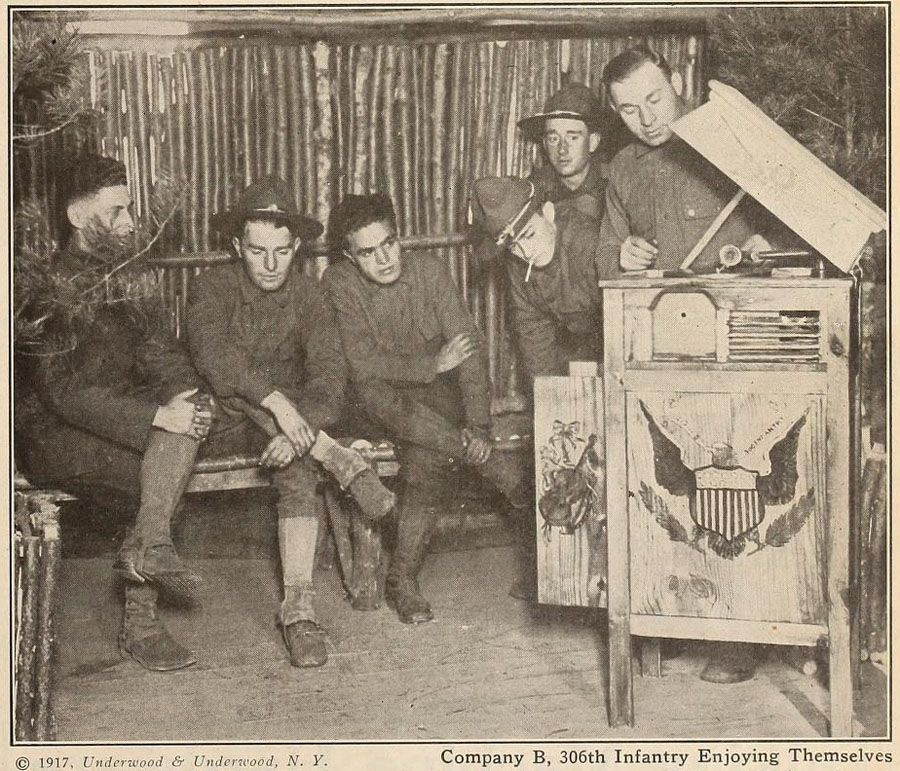
The Talking Machine
World, January 15, 1918
Note the following sheet music and
the contrasting American opinions exemplified by the American anti-war
song of 1915 "I Didn't Raise My Boy to be a Soldier" to
this 1918 "I'm Glad to be the Mother of a Soldier Boy."
This morphying was suggested to me by Allen Koenigsberg with
his example of the 1917 song "I'm glad I raised my boy to be
a soldier!" (poem and copyright by Wm. F.J. Smith ; music by
R.A. Browne, 1917, monographic,
(Library of Congress).

"I'm Glad to be the Mother of a
Soldier Boy," by Bronner and Bowers, Frederick V. Bowers, Inc.
Music Publishers, New York, 1918. (Courtesy
The
Lester S. Levy Collection of Sheet Music, The Sheridan Libraries,
Johns Hopkins University).
The Bugle
In the First World War "the introduction
of telegraphs, field telephones and wireless" resulted in the
bugle being used less for communicating field instructions than in
previous wars (see below for an example of a World War I "trench"
bugle which also speaks for itself how different this war was in defining
the battlefield). Bugle calls, of course, were part of daily military
life in camps (e.g., Reveille, Assembly, Mess calls, Recall, Taps)
and for ceremonies such as funerals. (8)
All the garden flowers and bead
wreaths in Beaufort had been carried out and put on the American
graves. When the squad fired over them and the bugle sounded, the
girls and their mothers wept. Poor Willy Katz, for instance, could
never have had such a funeral in South Omaha. (p. 574)
The World War One 'descriptive' record
“A Church Service On The
Battlefield" by Russell Hunting included a bugle call in
response to an imminent attack.

Sheet music by Irving Berlin, published
by Waterson, Berlin & Snyder, New York (1918). Courtesy Music Division,
The New York Public Library
LISTEN
to "Oh! How I Hate to get up in the morning" by Arthur
Fields, Edison 4-minute celluloid cylinder, Record No. 3639, recorded
July 16, 1918 (Courtesy i78s.org)
G. P. Cather, the prototype for Claude
Wheeler, played the bugle and his family donated G.P.'s bugle to the
Willa Cather Foundation. The Collection's on-line
information about G.P. Cather's bugle includes the following:
J.W. Pepper brass bugle, circa 1904.
Grosvenor P. Cather performed with several bands during his time at
Grand Island College, and he was the bugler of the College Cadets
drill team. The bugle, though showing its age, was a cherished Cather
family heirloom. A crude “C” can be seen in the brass near the mouthpiece."
"G. P.'s family was under the
impression he took the bugle to Texas on the Mexican Expedition."
(9)

Credits: OBJ-335-001. Charlotte Shaw
and Kenneth Smith Collection. Willa Cather Foundation Collections
and Archives at the National Willa Cather Center in Red Cloud, NE.
This brass military bugle (below) is
from the Minnesota
Historical Society and is an example of the M1894 bugle in B flat,
or "Trench" bugle used during World War I. (10)

There are a number of phonograph records
made demonstrating military bugle calls or with the bugle call as
part of a descriptive record or song.
U.S.
Army bugle calls (No. 1) by S. W. Smith (U.S.N.) & Bugle Squad,
Edison 4-minute celluloid cylinder No. 3331, recorded August 1, 1917
(Courtesy i78s.org)
U.S.
Army bugle calls (No. 2) by S. W. Smith (U.S.N.) & Bugle Squad,
Edison 4-minute celluloid cylinder No. 3332, recorded August 1, 1917
(Courtesy i78s.org)
 f f
A
Soldier's Day (The Way Army Bugle Calls Sound To the Boys) by
Geoffrey O'Hara, Victor 10" double-sided disc, Date
April 18, 1918, Record No. 18451 (Courtesy i78s.org)
Home, Sweet Home
When they walked back across the
square, over the crackling leaves, the dance was breaking up. Oscar
was playing "Home, Sweet Home," for the last waltz. " (p. 580)

"Home
Sweet Home" sung by Alma Gluck, Victor Red Seal 74251,
1911 (Courtesy of i78s.org)

"Home, Sweet Home,"
on the Gramophone. Postcard 1906 (PM-0669)


"Home,
Sweet Home The World Over," November 1912 Edison Phonograph
Monthly, 4-minute Edison Blue Amberol Record No. 1600 (Courtesy
i78s.org)
This pre-war recording of "Home,
Sweet Home" includes Germany, soon to be in conflict with the
other Home, Sweet Home examples on this record (e.g., Spain,
Italy, Scotland, Ireland and the USA).
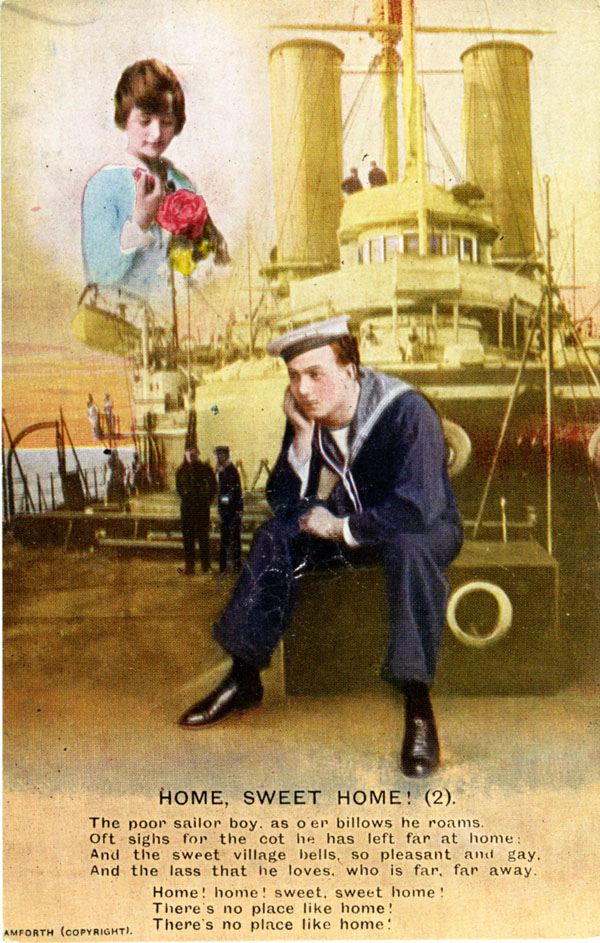
"Home, Sweet Home"
postcard ca. 1916 (PM-1612)
"Oh, I expect he's
found some shoulder to cry on. Do you realize, Claude, you and I
are the only men in the Company who haven't got engaged? Some of
the married men have got engaged twice. (p. 580)

"You'll Have to
Put Him to Sleep with the Marseillaise and Wake Him Up with a Oo-La-La,"
Sterling and Von Tilzer, Harry Von Tilzer Music Publishing, New
York, 1918 (Lester S. Levy Sheet Music Collection, Johns Hopkins).
LISTEN
to "You'll Have to Put Him to Sleep..." sung by Arthur
Fields, Edison 10" Diamond Disc Record No. 50501, February
1919 (Courtesy David Giovannoni Collection).
It's a good thing we're
pulling out, or we'd have banns and a bunch of christenings to look
after." "All the same," murmured Claude, "I like the women of this
country, as far as I've seen them." While they sat smoking in silence,
his mind went back to the quiet scene he bad watched on the steps
of that other church, on his first night in France; the country
girl in the moonlight, bending over her sick soldier. (p. 580)

"I'm
Crazy Over Every Girl In France," Sung by Avon Comedy
Four, Columbia Record No. A2399, Recorded December 13, 1917 (Courtesy
i78s.org)
When they walked back across the
square, over the crackling leaves, the dance was breaking up.
Oscar was playing "Home, Sweet Home," for the last waltz. "
Le dernier baiser ," said David.
"Well, tomorrow we'll be gone, and the chances are we won't come
back this way." (p. 580)

"Take me Back to
Dear Old Blighty" postcard circa 1917 (PM-0354)

"Take
me Back to Dear Old Blighty" by Arthur Fields, Emerson
Record No. 934, 9" double-side disc, March 1918 (Courtesy i78s.org)
Back home in America the silent moving
picture drama "The Claws of the Hun" starring Charles
Ray was at movie theaters. The plot is "an American munitions
manufacturer and his son become ensnarled with enemy agents from
Germany during the First World War." (IMDB).

"The Claws of
the Hun," Lobby card, Paramount Pictures, 1918

"I'm Giving You to Uncle Sam"
Lyric by Thos. H. Ince, Music by Victor Schertzinger, Frank J. Hart
Southern Californa Music Company, Los Angeles, 1918. Sheet music source:
University
of South Carolina Library - Joseph M. Bruccoli Great War Collection.
Note the US Capitol Building in the background.
The sheet music for "I'm Giving
You to Uncle Sam" notes that it's the theme of this movie. This
was a silent movie so the "theme" here means the World War
I setting and what's at stake if secrets are given to the Germans
(and not this being the theme song).
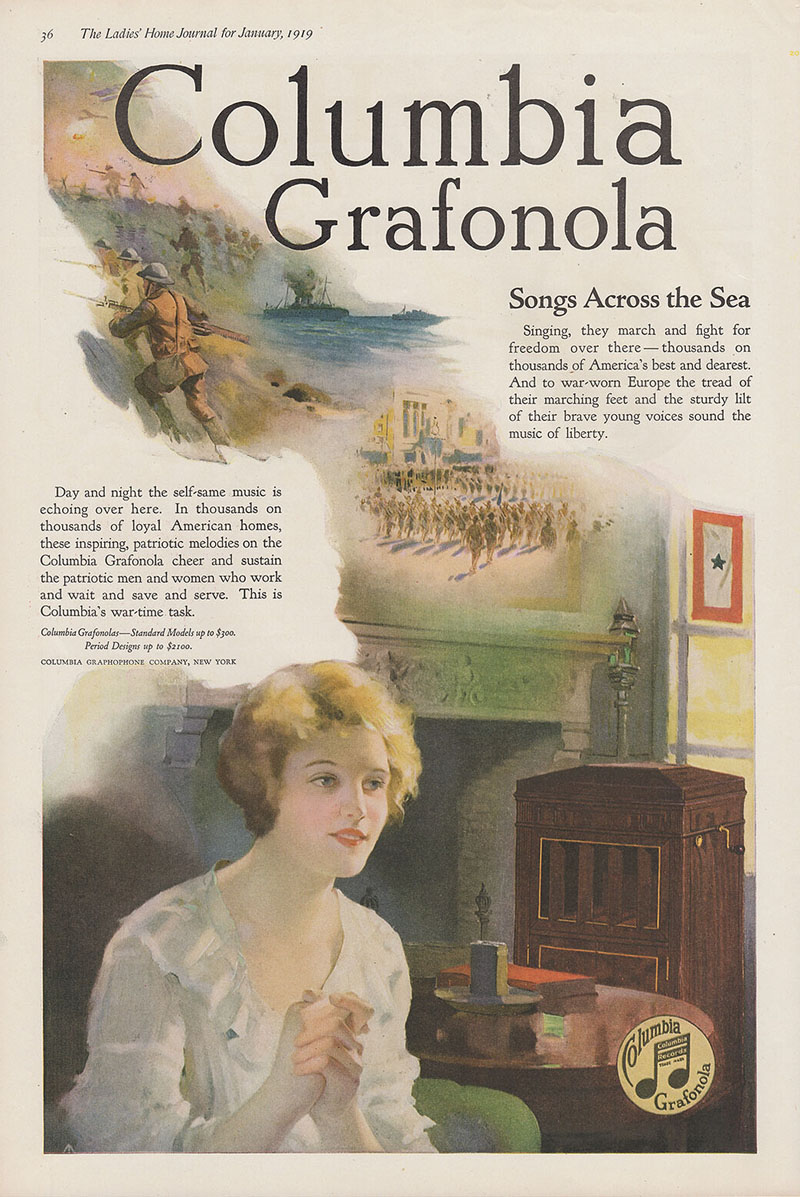 . .
Columbia Grafonola, January
1919 - Visualizing with Songs Across the Sea (PM-0845)
The Columbia Grafonola's
war-time task: To provide inspiring, patriotic melodies and "cheer
and sustain the patriotic men and women who work and wait and save
and serve."
A Mother's Loss

Photograph of American
machine gun troops in "Great Cantigny Advance"
(11)
G. P. Cather died in
action at Cantigny (12)
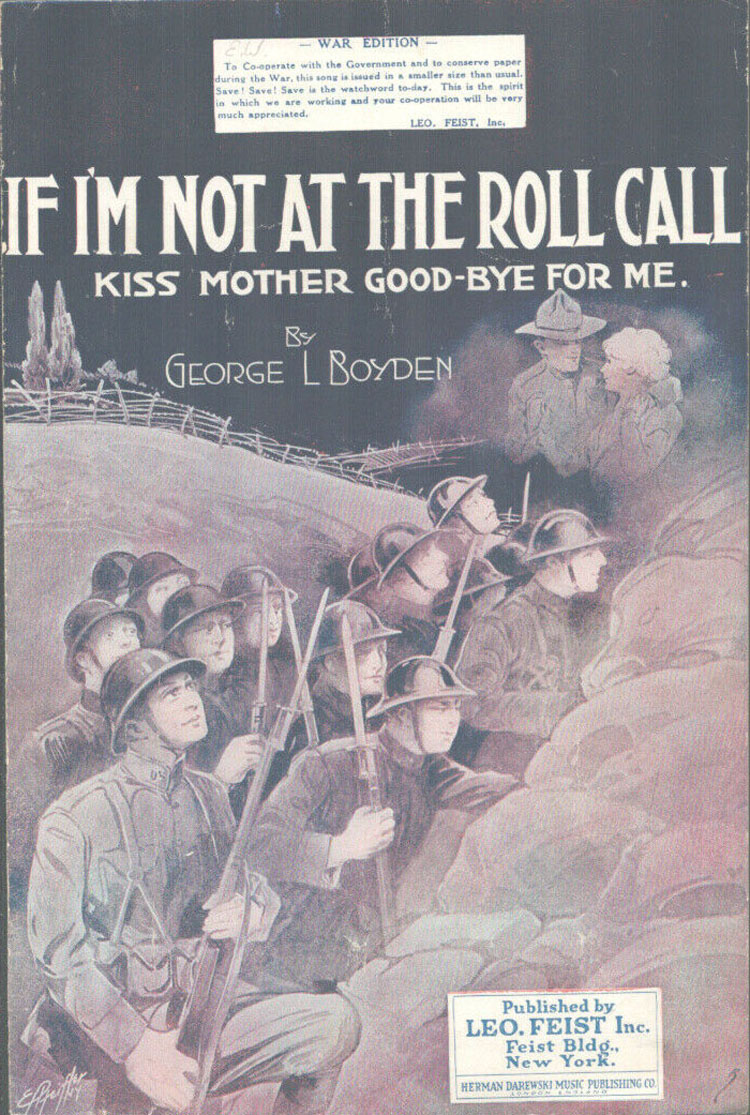
"If I'm Not at the Roll Call Kiss
Mother Good-bye for Me." By George Boyden, published by Leo.
Feist, New York, 1918

"If
I'm Not at the Roll Call (Kiss Mother Good-bye for Me)" by
George Boyden, performed by Campbell
and Burr, Columbia A2641, 1918 (Courtesy
Internet Archive)

"If
I'm Not at the Roll Call Kiss Mother Good-bye for Me" by
Harvey Hindermeyer (as Harvey Wilson). Edison Domestic Series No.
3630, 4-minute celluloid cylinder recorded August 6, 1918 (Courtesy
of i78s.org)
"Break the News
to Mother"
Mrs. Wheeler got the word of his
death one afternoon in the sitting-room, the room in which he had
bade her good-bye. She was reading when the telephone rang.
"Is this the Wheeler farm? This
is the telegraph office at Frankfort. We have a message from the
War Department,—" the voice hesitated. "Isn't Mr. Wheeler there?"
"No, but you can read the message
to me."
Mrs. Wheeler said, "Thank you,"
and hung up the receiver. She felt her way softly to her chair.
She had an hour alone, when there was nothing but him in the room,—but
him and the map there, which was the end of his road. Somewhere
among those perplexing names, he had found his place.
Claude's letters kept coming for
weeks afterward; then came the letters from his comrades and his
Colonel to tell her all. (p.603)
"Break the News to Mother" is a
war song first released in 1897 and popular during the Spanish–American
War. (See Phonographia's
PhonoMultimedia "Break the News to Mother" magic lantern
presentation accompanied by 1904 cylinder recording of J.W. Myers
singing "Break the News to Mother.")

"Break the News to Mother"
was re-released during World War I with various companies recording
it including Edison's 4-Minute Blue Amberol Record "Break the
News to Mother" Record No. 34366 sung
by George Ballard and Chorus (released February, 1918); the 1917
Victor
Record No. 18358-A by Shannon Four; and Columbia Grafonola's July
1917 release of Record
No. A2436 by Henry Burr and Columbia Stellar Quartette.

"Break the News to Mother" sheet
music by Chas. K. Harris, published by Chas. K. Harris, 1917 (Courtesy
The
Internet Archive)
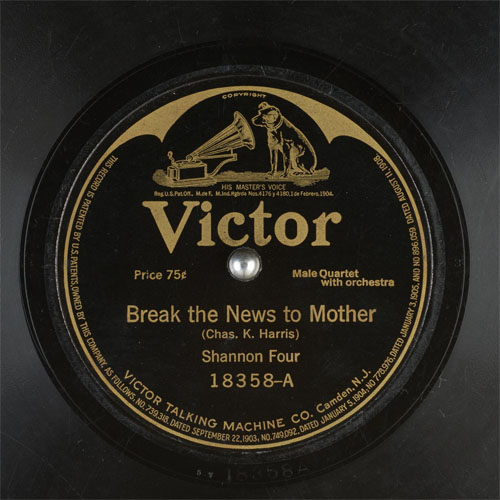
"Break
the News to Mother," Victor Record No. 18358-A by Shannon
Four, 1917 (Courtesy Internet Archive)

"Break the News to Mother" by George Wilton Ballard,
Edison Domestic Series No. 3436, 4-minute celluloid cylinder recorded
November 20, 1917 (Courtesy of i78s.org)

"When You Break the News to Mother
Tell Her Our Side is On Top" sheet music by Marie Robinson, published
by Delmar Music Co., Chicago, 1919 (Courtesy Library
of Congress)
The Armistice - The Fighting Ends:
At the 11th hour on the 11th day of the 11th month of 1918
Recorded Sound - The Moment the
Guns Fell Silent, Ending World War I
An exhibit at the Imperial War Museum
in London uses seismic data collected during the war to recreate
the moment the Armistice went into effect. Read the Smithsonian
Magazine article by Jason Daley (November 9, 2018) for more
details about how the sound of the last minutes of battle was recreated
in a way that allows "visitors to both hear and feel the moment
the Armistice went into effect and the guns fell silent."
To listen to the interpretation of
the Armistice moment, visit Imperial War Museum - WW1 Armistice
Interpretation (Sound Installation) by Coda
to Coda.

(Courtesy Imperial
War Museum and Smithsonian Magazine)

Okeh Records Victory
Music, The Talking Machine World, December 15, 1918
Good-Bye France
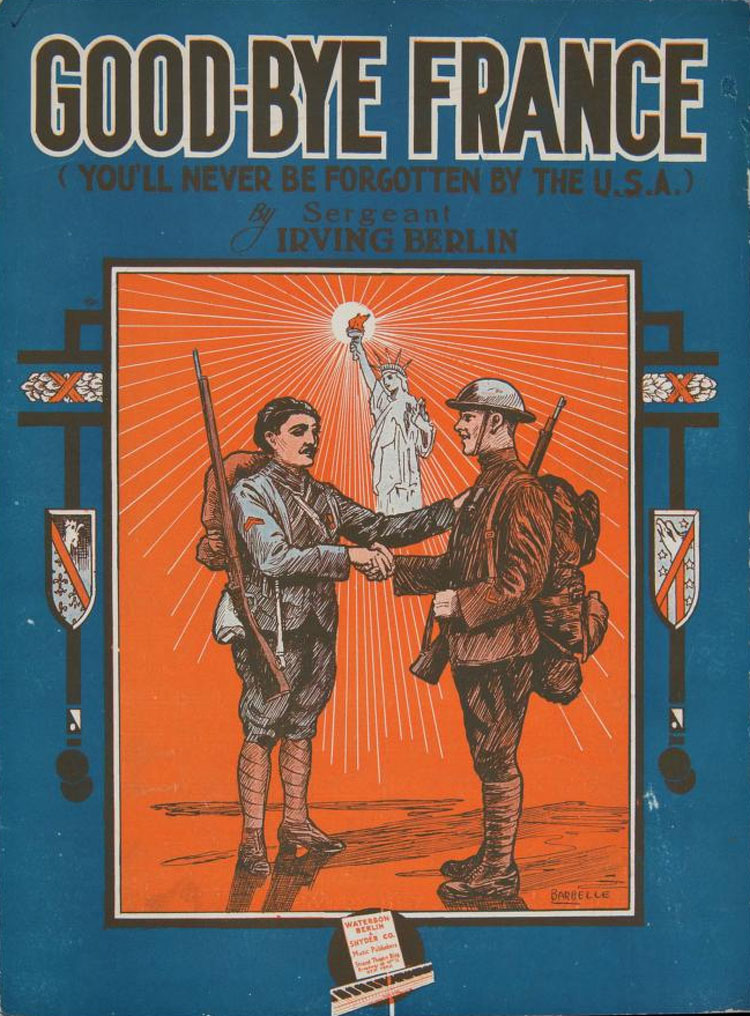
Sheet music "Good-Bye France (You'll
Never Be Forgotten by the U.S.A.) by Irving Berlin, published by Waterson,
Berlin & Snyder Co., New York, 1918 (Courtesy Internet Archive)

"Good-Bye
France," by Nora Bayes, Columbia Record A2678, 10" disc,
Recorded on November 15, 1918 (Courtesy i78s.org)
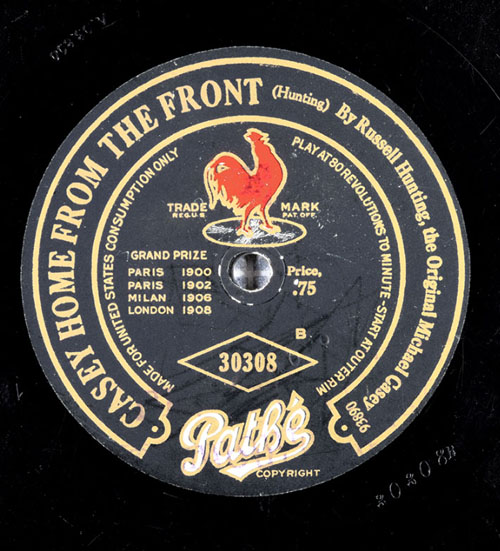
"Casey
Home From The Front" by Russell Hunting, Double Sided Disc
12" - Pathe Record 30308 (Courtesy
i78s.org) (Disclaimer)
Peace and "A
new era of record prosperity opens before you."

"Everybody's Happy Now" by
James Kendis, James Brockman, and Nat Vincent; Kendis Brockman Music
Co., New York, 1918. (Courtesy Library
of Congress)

"Everybody's
Happy Now" sung by Ben Linn, Emerson Phonograph Co., No.
7452, 1918 (Courtesy of i78s.org)

Emerson Records, The
Talking Machine World, December 15, 1918
The American phonograph industry had
actually done very well between 1914 and 1919 and had experienced
a "tremendous boom in sales."(5)
War related songs and patriotic
selections were numerous in the United States during World War I and
they would continue to be popular after the war ended.
One page (below) from a 1918 catalog
by F. K. Babson, a major phonograph and record distributor for Edison,
shows just a few of those offerings.

F. K. Babson catalog ca. 1918 (Courtesy
"Edison Blue Amberol Recordings Vol II" by Ron Dethlefson,
APM Press, New York, 1981 p.157
A Phonograph
Shop, January 1919

A customer in January
1919 who entered a shop that sold Victor Records just after the war
ended saw signage about the newest records released such as this The
JANUARY Victor Records are here.
To listen to those Victor records and
see their sheet music connections (including many World War I songs),
visit Phonographia's New Victor Records
January 1919.

(PM-0534)

"Pershing
for President" by Arthur Fields, Lyric Record 5135-A, circa
1919 (Courtesy of i78s.org)
Summary
One of Ours includes popular
culture details for the time period of a boy growing up on a Nebraska
ranch until he went to France to fight in World War I, "the war
to end war." (6B)
The extracted examples of its ephemera
and popular culture are insignificant compared to the implosion of
Europe and the devastation created by World War I. "The total
number of military and civilian casualties in World War I was around
40 million. There were 20 million deaths and 21 million wounded."
(7). "More
than a third of German males born between 1892 and 1895 died in the
course of the war." (7A)
The one hundredth anniversary of its
publication One of Ours is a reminder that stories can be
enduring and multi-layered with its popular culture displayed in the
midst of perennial themes such as human journeys, love, war and mortality.
Two examples of such stories are separated by three thousand years:
Achilles in the Trojan War as told in Homer's The Illiad and
Willa Cather's Claude Wheeler in One of Ours. One is a story
of a soldier's wrath; the other of a young man's naivete who grew
up to not regret a moment with his comrades in World War I.
During the1923 controversary about Cather
receiving the Pulitzer Prize for One of Ours there was some
"scathing" criticism related to Cather's depiction of some
battle scenes. However, Alex Ross wrote in his 2020 New Yorker
article "Willa Cather’s Quietly Shattering War Novel," that
this criticism did not understand Cather's "nuanced, ambivalent
portrait of the soldier spirit" and Cather's demotion of "the
war experience in favor of a longer view."
Ross addressed the negative reviews
related to Cather's depiction of war scenes with his explanation of
Cather's "longer view."
One of Ours,” Willa Cather’s
novel of youth, the prairie, influenza, and war, was one of the
author’s greatest successes, winning her the Pulitzer Prize in 1923.
It also elicited some of the most scathing criticism of her career.
Edmund Wilson called the novel a “pretty flat failure.” H. L. Mencken
said that its scenes of the First World War were “fought out, not
in France, but on a Hollywood movie-lot.” Ernest Hemingway wrote,
to Wilson, “Wasn’t that last scene in the lines wonderful? Do you
know where it came from? The battle scene in Birth of a Nation.
I identified episode after episode, Catherized. Poor woman she had
to get her war experience somewhere.”
"The author herself wondered
whether she had fallen short in the culminating battlefield scenes,
in which a naïve young Nebraskan named Claude Wheeler goes to his
death."
"What may have irritated
Cather’s contemporaries was not the inaccuracy of her military scenes—and
there are a few howlers to be found—but the way that she demotes
the war experience in favor of a longer view. From the outset of
the book, she tracks the spread of a male disease of pride and fear."
Celebrated antiwar novels by
the likes of Hemingway, John Dos Passos, Ford Madox Ford, and Erich
Maria Remarque were unambiguously blunt in showing the brutality
of the war and the duplicity of its rhetoric. Cather was more reserved,
to the point that many readers thought she still believed in the
“Great Crusade.”
One can understand how this nuanced,
ambivalent portrait of the soldier spirit failed to satisfy radical-minded
readers of the period. Claude learns nothing; he is a fool, albeit
a holy kind of fool. The war is simply the setting for the last
act of his rambling drama. But one can also guess that Cather’s
keen-eyed, skeptical exploration of American masculinity went over
the heads of the male-dominated literary community of her time.
(Alex
Ross, July 7, 2020, The
New Yorker).
The masculine culture of winners and
losers was not limited to the literary community or to war. The advertising
language of consumerism used during World I by the Victor Talking
Machine Company included their phrase “Victor
Supremacy” which promoted the supremacy of their Victrola as a
musical "instrument" and the supremacy of Victor's
recording artists as the "World's Greatest Artists."
Those ads were also suggesting a triumph
over the impermanence of sound. Victor's
"singers and instrumentalists" were said to be having their
art perpetuated by the Victor "for all time" with voices
that "can never die."
If Shakespeare or Puck
had seen ads promoting the immortality
of humans in the context of war they would probably have annotated
it with "What Fools These Mortals Be!"

The phonograph did clearly alter the
human conception of ephemeral sound and recorded artistic works can
live for generations.
But did that mean sound and recording
artists were now immortal?
In France, when David explains to Claude
why he's never been sorry to be in the war he also expresses his belief
in immortality when he says to Claude:
I've sometimes wondered whether
the young men of our time had to die to bring a new idea into the
world . . . something Olympian. I'd like to know. I think I shall
know. Since I've been over here this time, I've come to believe
in immortality. (p. 539)
The phonograph advertising themes of
Immortality" and "voices that can never die" also relate
to the phonograph ads anticipating war-time victory with messaging
like "by these men we shall conquer!" The "moral and
spiritual forces...no man can measure" would make the "world
safe for Democracy." "The music the men have to enjoy"
must not be underestimated for the weight it will "throw into
the final balance of success."

Postcard circa 1919 (PM-0360)

"The moral and spirtual forces
that will carry us on to victory no man can measure." The
Talking Machine World, July 15, 1918
Victor ad in Life
Magazine, March 28, 1918 (PM-2008)
Victor Supremacy
Voices that "can
never die."
Voices that will
live "for all time."
Voices that "will
be heard in centuries to come."
Voices that "will
flow forever in undiminished beauty."
Practically every
great singer and instrumentalist recording for Victor of this
generation will have their art perpetuated "for all time."

The art of the greatest
artists cannot die "as long as there are ears to hear, their
Victor Records" and "the Victrola makes them immortal."
The National Geographic, 1918
Marshall Dodge said at the 1979
WYNC Storytelling Festival "a story is what holds us together,
and what is left when we leave."
But is
any sound or story truly immortal?
The Voyager
1 and Voyager 2 are each carrying a Golden
Record with its story of humans on earth and that record has the
possibility of lasting longer than humans on earth. As Carl Sagan
noted, however, that record will only be played "if there are advanced
spacefaring civilizations in interstellar space". (6)
If the Golden Record lives beyond humans
on earth and plays its stories billions of miles from Earth then that
would be as immortal as a human story could ever be.
For the rest of us immortality is relative
since time is relative. Each passing moment of the present becomes
the past. Time is a constant companion,
until it isn't.
I also believe what Emily St John Mandel
wrote in her novel Station Eleven that "survival is not sufficient."
Art and stories can go beyond generations if they are preserved and
shared.
With Claude Wheeler's last breath he
withdrew from our time and our sight.
Willa Cather, however, left us his story
and with it generations can remember Claude Wheeler as a human being
of planet Earth who lived in a time and place and was "One of
Ours."
CITATIONS
and DISCOGRAPHY

Phonographia
|
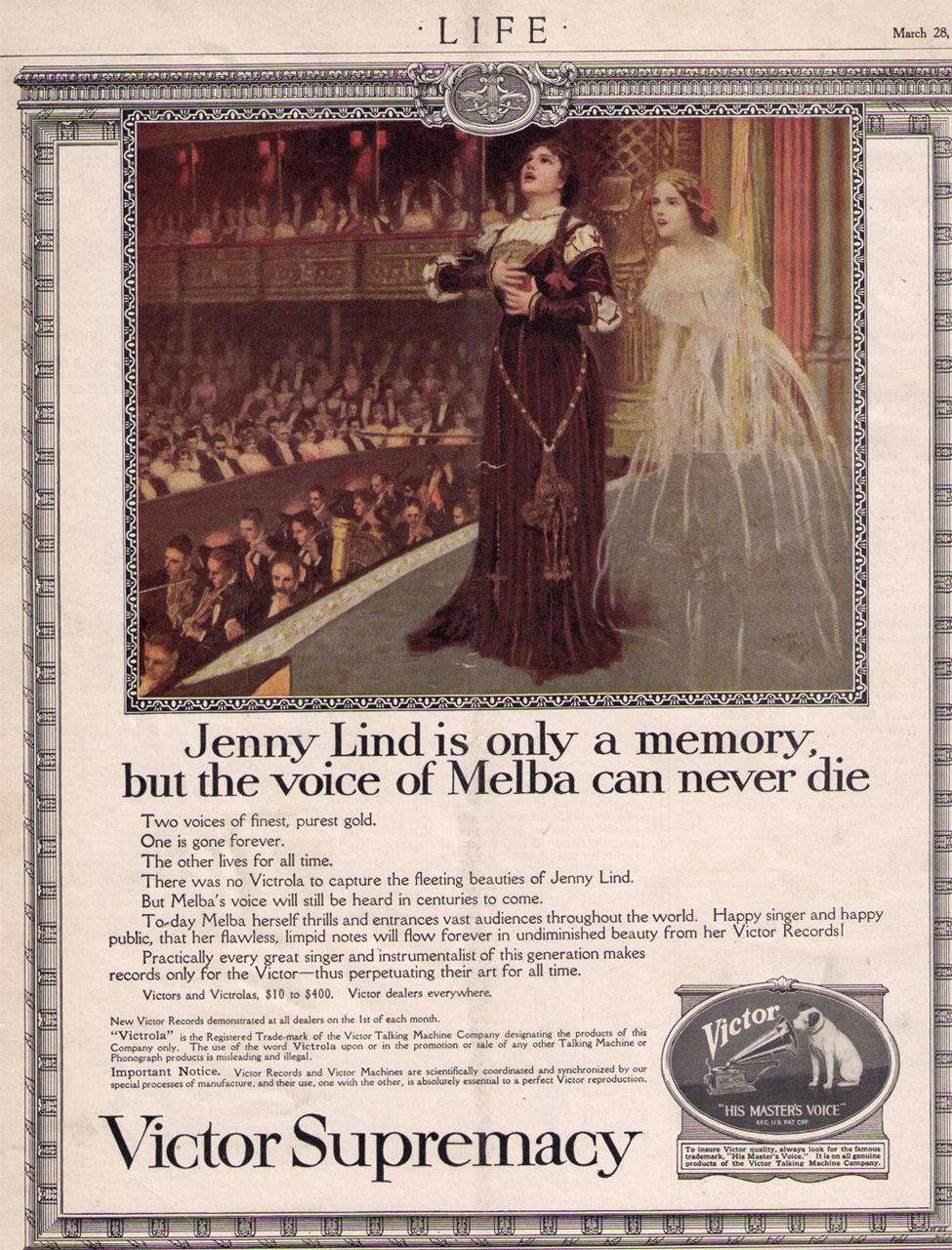
























































































































































 .
.






















